Birds
One of great attraction of Mt. Takao is to be able to observe all kinds of birds. Its number is almost 150 kinds which is one third of the species confirmed in all over Japan. Mt. Takao is the paradise for birds and one of the best place for bird watching. Various kinds of birds and its lifestyle could be observed including summer birds come in spring time, winter birds come from the higher altitude and hearing beautiful bird songs during breeding season.
-
(日本語) 高尾山がつなぐ野鳥と木の実

 (日本語) 高尾山がつなぐ野鳥と木の実
(日本語) 高尾山がつなぐ野鳥と木の実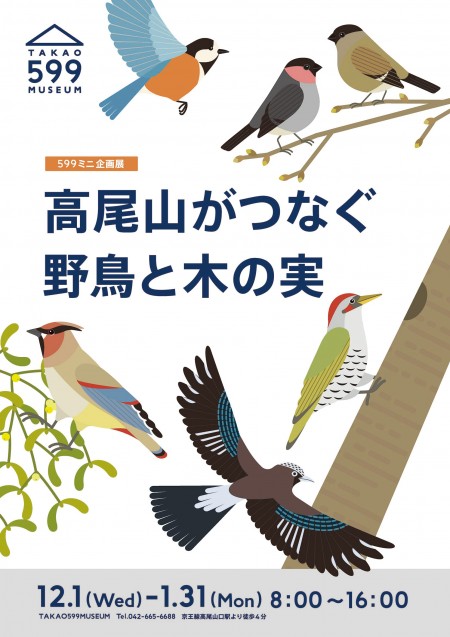 2021年12月1日~2022年1月31日「高尾山がつなぐ野鳥と木の実」
2021年12月1日~2022年1月31日「高尾山がつなぐ野鳥と木の実」
高尾山で見られる野鳥たちとカラフルな木の実をご紹介します。秋から冬にかけて実る木の実は、野鳥たちのごちそう!登る前に立ち寄って、野鳥と出会うきっかけを探してみませんか? -
Phasianus soemmerringii (Copper Pheasant) Phasianidae
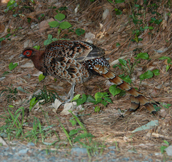
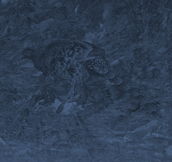 Phasianus soemmerringii (Copper Pheasant) Phasianidae
Phasianus soemmerringii (Copper Pheasant) Phasianidae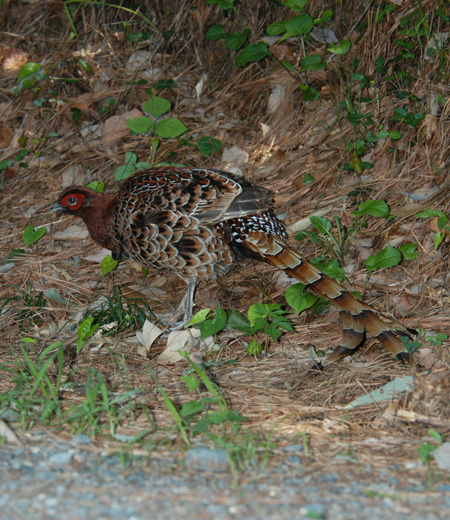 This is in the phasianidae family only distributed in Japan. This species is larger than the Japanese pheasant and the tail of males is longer than the head and body length. Whereas the Japanese pheasant prefers sunny areas, this species prefers shady forests. The body color is brownish for both males and females that blends in the background and is not easy to find them. The voice is not too loud “coo coo coo coo”. They walk between trees and hunt for insects, earthworms, seeds of plants and trees and buds of trees. The breeding season is from April to June, males become more active and do drumming (make sound by fluttering wings and make “doo doo doo doo” sounds) to announce their territory. They build a nest in hollows of a tree by collecting fallen leaves and tree barks and lay seven to ten eggs in a season.
This is in the phasianidae family only distributed in Japan. This species is larger than the Japanese pheasant and the tail of males is longer than the head and body length. Whereas the Japanese pheasant prefers sunny areas, this species prefers shady forests. The body color is brownish for both males and females that blends in the background and is not easy to find them. The voice is not too loud “coo coo coo coo”. They walk between trees and hunt for insects, earthworms, seeds of plants and trees and buds of trees. The breeding season is from April to June, males become more active and do drumming (make sound by fluttering wings and make “doo doo doo doo” sounds) to announce their territory. They build a nest in hollows of a tree by collecting fallen leaves and tree barks and lay seven to ten eggs in a season.
●Body Length (head to tail) Male about 125 cm / Female about 55 cm
●Season January to December (resident bird: a bird that stays in the same area all year round) -
Bambusicola thoracica (Bamboo Partridge) Phasianidae
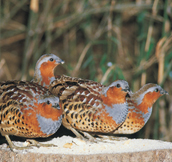
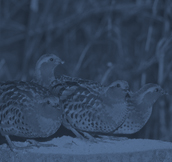 Bambusicola thoracica (Bamboo Partridge) Phasianidae
Bambusicola thoracica (Bamboo Partridge) Phasianidae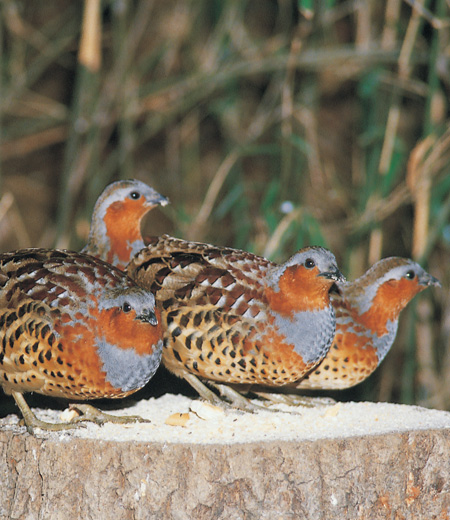 This is a foreign species native to southern China. After released 20 of them in Tokyo and Kanagawa prefectures in 1919 (Taisho 8), they are now distributed throughout Japan. They are found in woods, shrubs and grasslands in flatlands. They live in a group from autumn to early spring and feed on seeds, nuts, young leaves and buds of trees and earthworms. Their voice sounds like “come here” (chottokoi) in Japanese and had often been used in TV programs, movies and samurai dramas as the birds that live in satoyama (satoyama is where residential area and woods space coexist in a rural area). The breeding season is from May to June. They dig shallow holes in shrubs and build a nest with fallen plants and lay seven to eight eggs in a season.
This is a foreign species native to southern China. After released 20 of them in Tokyo and Kanagawa prefectures in 1919 (Taisho 8), they are now distributed throughout Japan. They are found in woods, shrubs and grasslands in flatlands. They live in a group from autumn to early spring and feed on seeds, nuts, young leaves and buds of trees and earthworms. Their voice sounds like “come here” (chottokoi) in Japanese and had often been used in TV programs, movies and samurai dramas as the birds that live in satoyama (satoyama is where residential area and woods space coexist in a rural area). The breeding season is from May to June. They dig shallow holes in shrubs and build a nest with fallen plants and lay seven to eight eggs in a season.
●Body length about 27 cm
●Season January to December (resident bird: a bird that stays in the same area all year round)(未翻訳)鳴き声を聞く
-
Anas poecilorhyncha (Spot-billed Duck) Anatidae
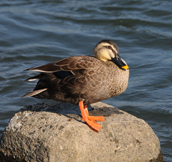
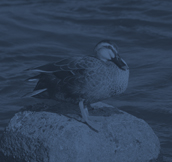 Anas poecilorhyncha (Spot-billed Duck) Anatidae
Anas poecilorhyncha (Spot-billed Duck) Anatidae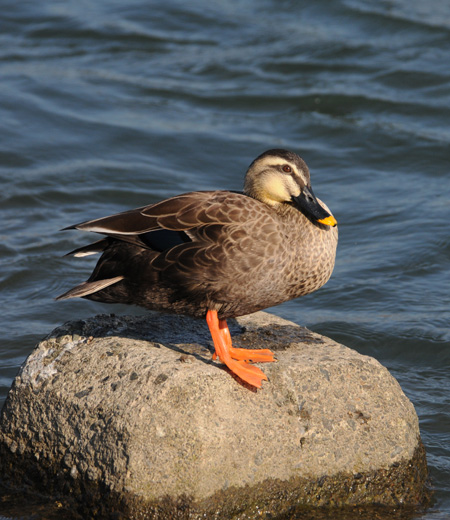 This duck is distributed throughout Japan. They are found in the waterside including lakes, ponds, rivers, paddy fields and ponds at parks. They raise chicks even at man-made ponds at office streets in cities often covered on TV programs. Most female ducks have brighter colored wings but this species has almost the same color with males. They are normally active at night but after increased in number, they are often seen eating food at parks in cities during the daytime. They prefer fruits of plants but they are omnivorous and also feed on fish and insects. The breeding season is from April to early July. They build a nest with fallen leaves and plants covered with feather of parents’ breast in shrubs near waterside and lay eight to thirteen eggs in a season.
This duck is distributed throughout Japan. They are found in the waterside including lakes, ponds, rivers, paddy fields and ponds at parks. They raise chicks even at man-made ponds at office streets in cities often covered on TV programs. Most female ducks have brighter colored wings but this species has almost the same color with males. They are normally active at night but after increased in number, they are often seen eating food at parks in cities during the daytime. They prefer fruits of plants but they are omnivorous and also feed on fish and insects. The breeding season is from April to early July. They build a nest with fallen leaves and plants covered with feather of parents’ breast in shrubs near waterside and lay eight to thirteen eggs in a season.
●Body Length about 61 cm
●Season January to December (resident bird: a bird that stays in the same area all year round) -
Streptopelia orientalis (Oriental Turtle Dove) Columbidae
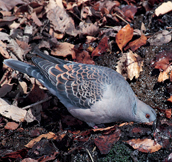
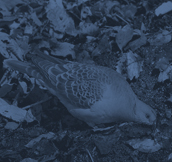 Streptopelia orientalis (Oriental Turtle Dove) Columbidae
Streptopelia orientalis (Oriental Turtle Dove) Columbidae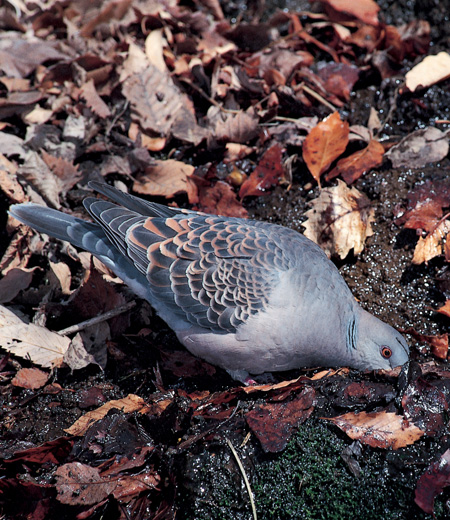 The Japanese name Kijibato was named because the red-brown feather patterns resemble pheasants. They are also called Yamabato literally meaning birds in mountains but they are distributed widely even at parks and street trees in cities. They rest on electric wires and chirp with low voice “coo coo coo”. They feed mainly on nuts of trees and plants, also breads and cereals. The married couple lives together and normally has a good relationship. During the breeding season, males bow repeatedly and fly upward fast and fly down for courtship. They build a simple nest with twigs from April to July and lay two eggs in a season.
The Japanese name Kijibato was named because the red-brown feather patterns resemble pheasants. They are also called Yamabato literally meaning birds in mountains but they are distributed widely even at parks and street trees in cities. They rest on electric wires and chirp with low voice “coo coo coo”. They feed mainly on nuts of trees and plants, also breads and cereals. The married couple lives together and normally has a good relationship. During the breeding season, males bow repeatedly and fly upward fast and fly down for courtship. They build a simple nest with twigs from April to July and lay two eggs in a season.
●Body Length about 33 cm
●Season January to December (resident bird: a bird that stays in the same area all year round) -
Sphenurus sieboldii (Japanese Green Pigeon) Columbidae
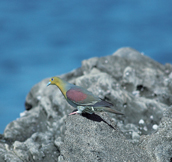
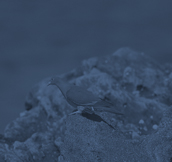 Sphenurus sieboldii (Japanese Green Pigeon) Columbidae
Sphenurus sieboldii (Japanese Green Pigeon) Columbidae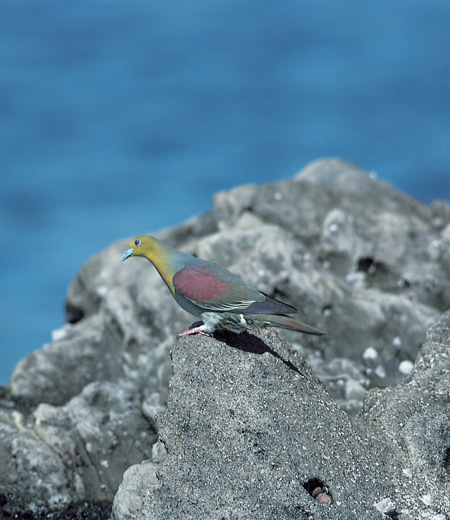 They are beautiful birds with a yellow-green body with a light blue bill. Male and female have almost the same body color but the male has purple feathers on wings. They live in a group in broad-leaved forests with Quercus acutissima, maple trees, Quercus crispula blume and hardly ever come out to open spaces. They feed on nuts like acorns, buds and fruits of trees. From early summer to autumn, they fly out to the coast to drink seawater and to hot springs for salty water. During the breeding season, males chirp like “oh ah oh” with lonely tones. In June, they build a dish-shaped nest with twigs and vines on a tree and lay two eggs in a season.
They are beautiful birds with a yellow-green body with a light blue bill. Male and female have almost the same body color but the male has purple feathers on wings. They live in a group in broad-leaved forests with Quercus acutissima, maple trees, Quercus crispula blume and hardly ever come out to open spaces. They feed on nuts like acorns, buds and fruits of trees. From early summer to autumn, they fly out to the coast to drink seawater and to hot springs for salty water. During the breeding season, males chirp like “oh ah oh” with lonely tones. In June, they build a dish-shaped nest with twigs and vines on a tree and lay two eggs in a season.
●Body Length about 33 cm
●Season January to December (resident bird: a bird that stays in the same area all year round, and wandering bird: a bird that has different areas for breeding and spending winter)(未翻訳)鳴き声を聞く
-
Columba livia (Rock Dove) Columbidae
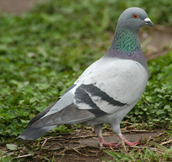
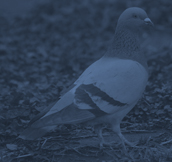 Columba livia (Rock Dove) Columbidae
Columba livia (Rock Dove) Columbidae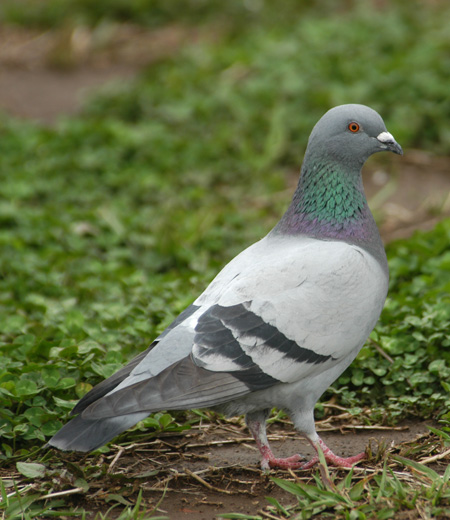 This is seen daily at parks and shrines, and commonly known as “dobato” in Japanese. This species is a foreign species bred to courier pigeons in Europe. Most of them have shiny purple and green feathers around neck and two black lines on wings but wings vary to black, gray, nut-brown due to breeding. Although most of birds need to hold water in a mouth once and swallow with their head lifted, they have a unique habit to drink water directly. They raise chicks with secretions called pigeon milk produced in crop.
This is seen daily at parks and shrines, and commonly known as “dobato” in Japanese. This species is a foreign species bred to courier pigeons in Europe. Most of them have shiny purple and green feathers around neck and two black lines on wings but wings vary to black, gray, nut-brown due to breeding. Although most of birds need to hold water in a mouth once and swallow with their head lifted, they have a unique habit to drink water directly. They raise chicks with secretions called pigeon milk produced in crop.
●Size about 31 to 34 cm
●Season January to December (resident bird: a bird that stays in the same area all year round) -
Gorsakius goisagi (Japanese Night Heron) Ardeidae
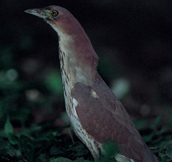
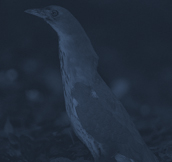 Gorsakius goisagi (Japanese Night Heron) Ardeidae
Gorsakius goisagi (Japanese Night Heron) Ardeidae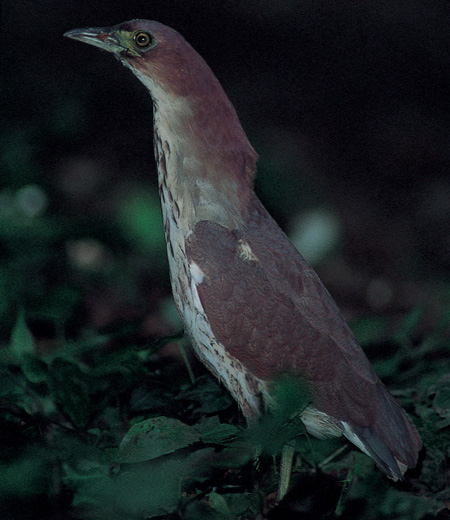 This is in the Ardeidae family and breeds during summer only in Japan. They live alone or in pairs in shady forests near streams of low elevations. The body color is dark brown for both males and females. They rest under shrubs during daytime and become active in the late afternoon. They hunt for earthworms, crayfish, frogs and fish in streams or ponds. When feeling danger, they lift a bill upward and stand still camouflaging their body to tree branches. The breeding season is from May to July and the males chirp “boo boo” with low voices repeatedly to ask females to mate. They build a dish-shaped nest with twigs on a branch extended over streams and lay four to five eggs in a season. After parenting in summer, they fly to Southeast Asia to spend winter.
This is in the Ardeidae family and breeds during summer only in Japan. They live alone or in pairs in shady forests near streams of low elevations. The body color is dark brown for both males and females. They rest under shrubs during daytime and become active in the late afternoon. They hunt for earthworms, crayfish, frogs and fish in streams or ponds. When feeling danger, they lift a bill upward and stand still camouflaging their body to tree branches. The breeding season is from May to July and the males chirp “boo boo” with low voices repeatedly to ask females to mate. They build a dish-shaped nest with twigs on a branch extended over streams and lay four to five eggs in a season. After parenting in summer, they fly to Southeast Asia to spend winter.
●Body Length about 49 cm
●Season April to September (resident bird: a bird that stays in the same area all year round) -
Nycticorax nycticorax (Black-crowned Night Heron) Ardeidae
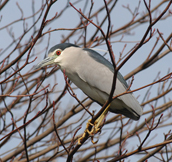
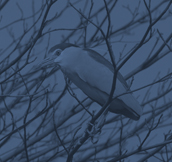 Nycticorax nycticorax (Black-crowned Night Heron) Ardeidae
Nycticorax nycticorax (Black-crowned Night Heron) Ardeidae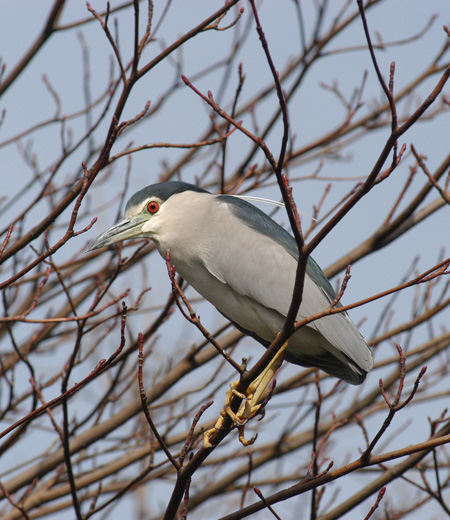 Just like other species in the Ardeidae family, they create the habitat area called colony in forests from flatlands to hills. They stay in a colony during daytime and hunt for fish, frogs and crayfish at waterside such as rivers, bogs and ponds at night. They wait for preys to come closer and catch immediately with bills. Males and females have same body color and there are people who say that they are like penguins. Adults have two decorative feathers on the back of a head. The young adults have white patterns on the brown body. They are called Hoshigoi and look completely different from adult birds. The breeding season is from April to August. They build nests with twigs on trees in a colony, and lay four to six eggs in a season.
Just like other species in the Ardeidae family, they create the habitat area called colony in forests from flatlands to hills. They stay in a colony during daytime and hunt for fish, frogs and crayfish at waterside such as rivers, bogs and ponds at night. They wait for preys to come closer and catch immediately with bills. Males and females have same body color and there are people who say that they are like penguins. Adults have two decorative feathers on the back of a head. The young adults have white patterns on the brown body. They are called Hoshigoi and look completely different from adult birds. The breeding season is from April to August. They build nests with twigs on trees in a colony, and lay four to six eggs in a season.
●Body Length about 57 cm
●Season January to December (resident bird: a bird that stays in the same area all year round) -
Ardea cinerea (Grey Heron) Ardeidae
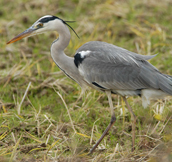
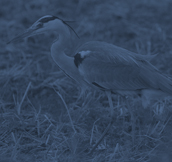 Ardea cinerea (Grey Heron) Ardeidae
Ardea cinerea (Grey Heron) Ardeidae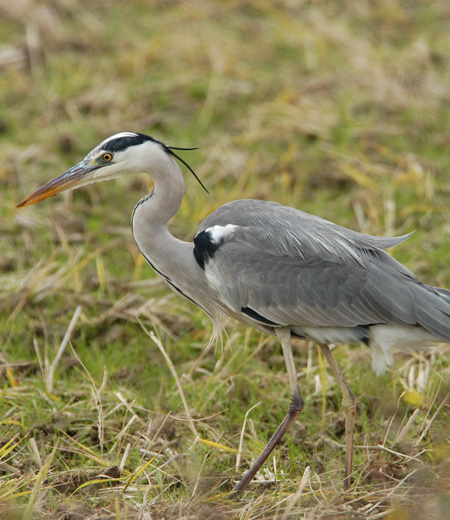 This is the largest heron distributed in Japan. They have skinny bodies with long legs and necks. The body color of males and females is bluish gray. Adults have decorative black feathers on a head but not on young birds. They live near coastline, mudflats, rivers, lakes, ponds and swamps, and sometimes come to streams on Mt. Takao. They rest in a group during daytime and hunt for preys from late afternoon to the following morning. They feed on fish, frogs, crayfish and sometimes snakes, rats and baby birds. They catch small fish with a bill and catch large fish by piercing them with the tip of a bill. They build a colony for breeding and build a dish-shaped nest with twigs on tall trees in forests. The breeding season is from April to May and they lay three to six eggs in a season.
This is the largest heron distributed in Japan. They have skinny bodies with long legs and necks. The body color of males and females is bluish gray. Adults have decorative black feathers on a head but not on young birds. They live near coastline, mudflats, rivers, lakes, ponds and swamps, and sometimes come to streams on Mt. Takao. They rest in a group during daytime and hunt for preys from late afternoon to the following morning. They feed on fish, frogs, crayfish and sometimes snakes, rats and baby birds. They catch small fish with a bill and catch large fish by piercing them with the tip of a bill. They build a colony for breeding and build a dish-shaped nest with twigs on tall trees in forests. The breeding season is from April to May and they lay three to six eggs in a season.
●Body Length about 93 cm
●Season January to December (resident bird: a bird that stays in the same area all year round) -
Egretta garzetta (Little Egret) Ardeidae
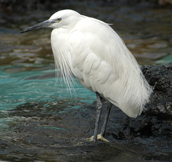
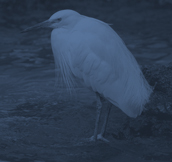 Egretta garzetta (Little Egret) Ardeidae
Egretta garzetta (Little Egret) Ardeidae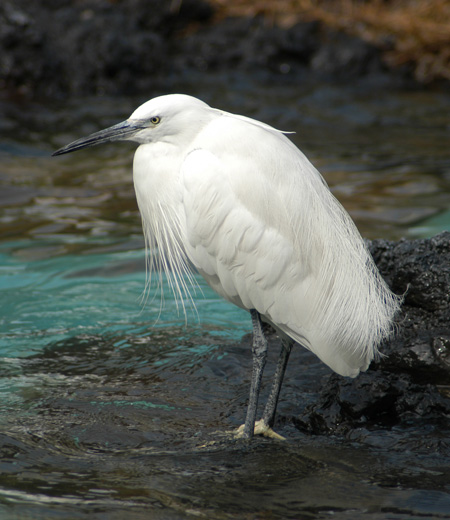 White species in the Ardeidae family are called egret and this species is the small sized egret. The largest one is the great egret, the next largest one is the intermediate egret and the smallest one is this species. The bill and toes are yellow base, which can identify this species from other two species. They live in lakes, ponds, paddy fields, bogs and mudflat and even rivers in cities. They build a colony with other egrets, fly to the waterside in the early morning to hunt for prey and come back to the colony in the late afternoon. They prefer fish, frogs and aquatic insects, and shake legs in shallow water to flush out prey hidden in muds. The breeding season is from April to August. They build a dish-shaped nest with twigs and fallen branches, and lay four to six eggs.
White species in the Ardeidae family are called egret and this species is the small sized egret. The largest one is the great egret, the next largest one is the intermediate egret and the smallest one is this species. The bill and toes are yellow base, which can identify this species from other two species. They live in lakes, ponds, paddy fields, bogs and mudflat and even rivers in cities. They build a colony with other egrets, fly to the waterside in the early morning to hunt for prey and come back to the colony in the late afternoon. They prefer fish, frogs and aquatic insects, and shake legs in shallow water to flush out prey hidden in muds. The breeding season is from April to August. They build a dish-shaped nest with twigs and fallen branches, and lay four to six eggs.
●Body Length about 61 cm
●Season January to December (resident bird: a bird that stays in the same area all year round) -
Cuculus poliocephalus (Lesser Cuckoo) Cuculidae
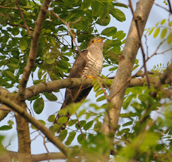
 Cuculus poliocephalus (Lesser Cuckoo) Cuculidae
Cuculus poliocephalus (Lesser Cuckoo) Cuculidae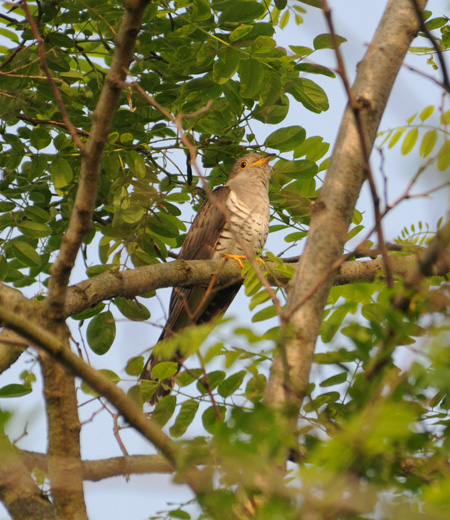 Is the same family with cuckoo and found in bright forests in low elevations. Male warbles loudly “kyo kyo kyo” sounding like “tokkyo kyoka-kyoku” literally meaning patent approval office, which is a very famous tongue twister. It also sounded like “hototogisu”, hence the Japanese name Hototogisui was named.
Is the same family with cuckoo and found in bright forests in low elevations. Male warbles loudly “kyo kyo kyo” sounding like “tokkyo kyoka-kyoku” literally meaning patent approval office, which is a very famous tongue twister. It also sounded like “hototogisu”, hence the Japanese name Hototogisui was named.
The back of adult birds is gray with black stripe patterns on chest. Male and female have same body color but some female are red-brown. Mainly feed on insects and hairy caterpillars and hornworms are favorites. Are brood parasites which means to lay eggs on other bird’s nest. Lay eggs often in bush warbler’s nest and the color of eggs are brown similar to the ones of bush warbler. The breeding season is from June to August. Take one egg out from the nest and lay one egg instead. In autumn, fly to Southeast Asia to spent winter.
●Body Length about 28 cm
●Season May to August (Summer bird, fly to one area from spring to summer for breeding and fly back to southern areas in autumn.)(未翻訳)鳴き声を聞く
-
Cuculus canorus (Common Cuckoo) Cuculidae

 Cuculus canorus (Common Cuckoo) Cuculidae
Cuculus canorus (Common Cuckoo) Cuculidae Come back to Japan in spring from the place where they spent winter. Live in sunny grassland with common reeds or highlands with Japanese larch. Live alone normally and rest on trees or electric wires to keep an eye on what is happening in surrounding areas. During breeding season, male warble “cuckoo” loudly and female chirp “pe pe pe pe” sharply. Prefers hairy caterpillars and hornworms but sometimes feed on eggs of birds and chicks. Are brood parasites which means to lay eggs on other bird’s nest. Lay eggs in nests of birds in acrocephalidae family, bull-headed shrike and bunting. The color of eggs varies but normally it becomes close to host birds’ ones. The breeding season is from May to August. Take one egg out from the nest and lay one egg instead. Hatched chick drop other eggs out from the nest.
Come back to Japan in spring from the place where they spent winter. Live in sunny grassland with common reeds or highlands with Japanese larch. Live alone normally and rest on trees or electric wires to keep an eye on what is happening in surrounding areas. During breeding season, male warble “cuckoo” loudly and female chirp “pe pe pe pe” sharply. Prefers hairy caterpillars and hornworms but sometimes feed on eggs of birds and chicks. Are brood parasites which means to lay eggs on other bird’s nest. Lay eggs in nests of birds in acrocephalidae family, bull-headed shrike and bunting. The color of eggs varies but normally it becomes close to host birds’ ones. The breeding season is from May to August. Take one egg out from the nest and lay one egg instead. Hatched chick drop other eggs out from the nest.
●Body Length about 35 cm
●Season May to July (Summer bird, fly to one area from spring to summer for breeding and fly back to southern areas in autumn.) -
Caprimulgus jotaka (Jungle Nightjar) Caprimulgidae
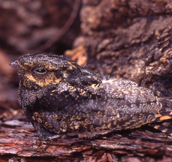
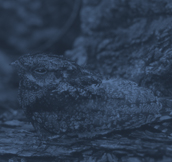 Caprimulgus jotaka (Jungle Nightjar) Caprimulgidae
Caprimulgus jotaka (Jungle Nightjar) Caprimulgidae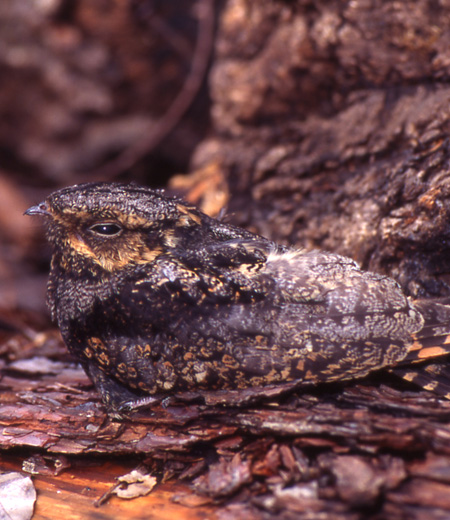 Found in grasslands and mountain forests. Sleep on tree branches during daytime and become active in late afternoon. Open wide mouth and hover low without making sound with feathers and suck moths or gold beetles that comes into their mouth. The body color of male and female is almost the same and black brown body with fine complicated patterns. The breeding season is from May to August. Male hold territory and fly over trees and chirp “qyo qyo qyo”. Does not build a nest and lay two to three eggs in a season on the ground covered with leaf soils in open areas in forests. In autumn, fly to Southeast Asia to spent winter.
Found in grasslands and mountain forests. Sleep on tree branches during daytime and become active in late afternoon. Open wide mouth and hover low without making sound with feathers and suck moths or gold beetles that comes into their mouth. The body color of male and female is almost the same and black brown body with fine complicated patterns. The breeding season is from May to August. Male hold territory and fly over trees and chirp “qyo qyo qyo”. Does not build a nest and lay two to three eggs in a season on the ground covered with leaf soils in open areas in forests. In autumn, fly to Southeast Asia to spent winter.
●Body Length about 29 cm
●Season April to about October (Summer bird, fly to one area from spring to summer for breeding and fly back to southern areas in autumn.) -
Apus affinis (House Swift) Apodidae
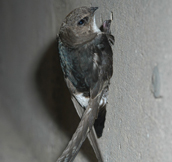
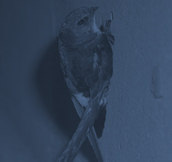 Apus affinis (House Swift) Apodidae
Apus affinis (House Swift) Apodidae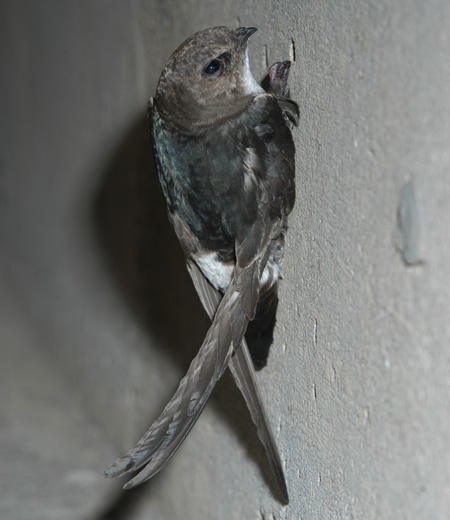 Are small sized pacific swift and was not in the old illustrated bird book in Japan. This species is observed from 1960 (Showa 35), and first confirmed them of breeding in 1967 (Showa 42). After that, are increased in number and also found them in Tama area and Tokyo 23 wards area. Chirp “chu li li li” and hunt for flies and mosquitoes in the air. Build nests with muds and feathers on the concrete walls underneath the elevated railways and roads. Sometimes borrow nests of house martins. The breeding season is from April to June and lay two to three eggs in a season. Birds in apodiformes order are the ones able to stretch four toes forward which enable this species to rest on vertical concrete walls.
Are small sized pacific swift and was not in the old illustrated bird book in Japan. This species is observed from 1960 (Showa 35), and first confirmed them of breeding in 1967 (Showa 42). After that, are increased in number and also found them in Tama area and Tokyo 23 wards area. Chirp “chu li li li” and hunt for flies and mosquitoes in the air. Build nests with muds and feathers on the concrete walls underneath the elevated railways and roads. Sometimes borrow nests of house martins. The breeding season is from April to June and lay two to three eggs in a season. Birds in apodiformes order are the ones able to stretch four toes forward which enable this species to rest on vertical concrete walls.
●Body Length about 13 cm
●Season January to December (resident bird, bird that stay in the same area all year round.) -
Milvus migrans (Black Kite) Accipitridae
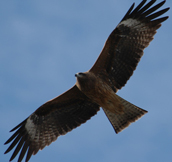
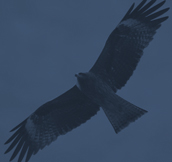 Milvus migrans (Black Kite) Accipitridae
Milvus migrans (Black Kite) Accipitridae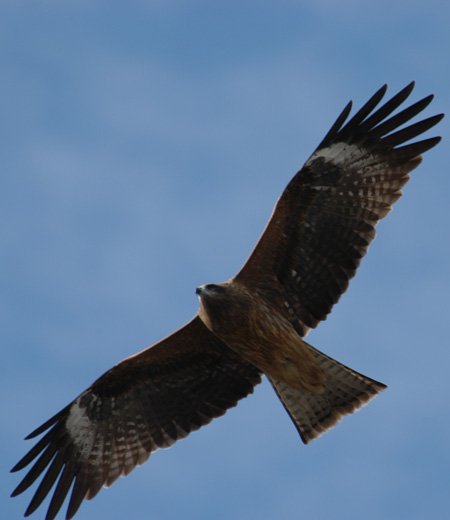 Is in a accipitridae family found at lakes, riverbeds and cities. Chirp “peep hyo lo lo lo” while hovering in a round route. Also known as tombi in Japanese. Is normally in a group except breeding season and hunt for preys from early in the morning. Feed on dead animals, fish, insects and frogs and sometimes raid garbage. The body color for male and female is almost the same and adults have dark-brown body. When looking up the sky while they are flying, their trapezoidal-shaped tails are clearly seen. The breeding season is from March to May and mostly in pairs and chirp frequently. Build a large sized dish-shaped nest with layers of twigs on a tall tree. Lay two to three eggs in a season.
Is in a accipitridae family found at lakes, riverbeds and cities. Chirp “peep hyo lo lo lo” while hovering in a round route. Also known as tombi in Japanese. Is normally in a group except breeding season and hunt for preys from early in the morning. Feed on dead animals, fish, insects and frogs and sometimes raid garbage. The body color for male and female is almost the same and adults have dark-brown body. When looking up the sky while they are flying, their trapezoidal-shaped tails are clearly seen. The breeding season is from March to May and mostly in pairs and chirp frequently. Build a large sized dish-shaped nest with layers of twigs on a tall tree. Lay two to three eggs in a season.
●Body Length Male about 58 cm / Female about 68 cm
●Season January to December (resident bird, bird that stay in the same area all year round) -
Accipiter gularis (Japanese Lesser Sparrowhawk) Accipitridae
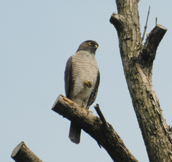
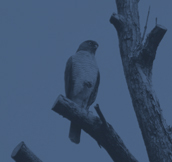 Accipiter gularis (Japanese Lesser Sparrowhawk) Accipitridae
Accipiter gularis (Japanese Lesser Sparrowhawk) Accipitridae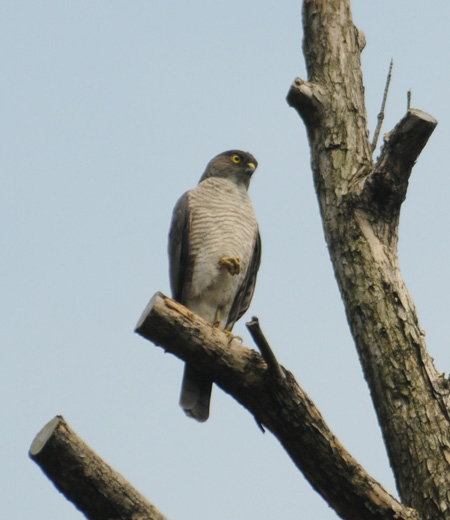 Is the smallest hawk in Japan. The ones live north of Kyushu is summer birds (fly to one area from spring to summer for breeding and fly back to southern areas in autumn) and fly to Southeast Asia in autumn to spend winter. Live in forests in mountains but also greed in small forests in city area. Fly to Honshu area from March to April in pairs. The body color is bluish black. Male is orange chest and red around eyes and female is gray chest and yellow around eyes. Mainly feed on small birds and sometimes insects. Chase and hunt for birds in forests. During breeding season, fly over trees and chirp “pyoh pyoh pyo pyo”. From May to August, build nests with twigs and branches of needle-leaved tree with leaves on tree and lay three to five eggs in a season.
Is the smallest hawk in Japan. The ones live north of Kyushu is summer birds (fly to one area from spring to summer for breeding and fly back to southern areas in autumn) and fly to Southeast Asia in autumn to spend winter. Live in forests in mountains but also greed in small forests in city area. Fly to Honshu area from March to April in pairs. The body color is bluish black. Male is orange chest and red around eyes and female is gray chest and yellow around eyes. Mainly feed on small birds and sometimes insects. Chase and hunt for birds in forests. During breeding season, fly over trees and chirp “pyoh pyoh pyo pyo”. From May to August, build nests with twigs and branches of needle-leaved tree with leaves on tree and lay three to five eggs in a season.
●Body Length Male about 27 cm, Female about 30 cm
●Season March to October (resident bird, bird that stay in the same area all year round, and wandering bird, bird that have different areas for breeding and spending winter)(未翻訳)鳴き声を聞く
-
Accipiter nisus (Eurasian Sparrowhawk) Accipitridae
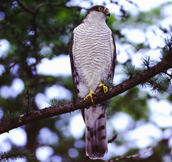
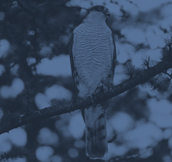 Accipiter nisus (Eurasian Sparrowhawk) Accipitridae
Accipiter nisus (Eurasian Sparrowhawk) Accipitridae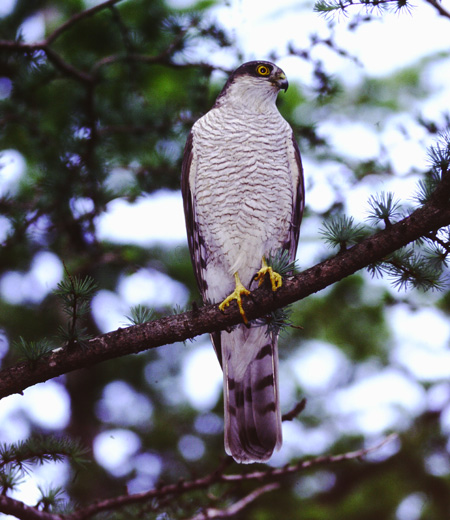 A kind of hawk found in forests from flatlands to 1,700 meters elevations. Have short wings with four black belt-like patterns on long tails. Most of them live in pairs during breeding season but alone except that season. Mainly feed on rufous turtle dove and great spotted woodpecker but sometimes rats. When sensing dangers, threatening enemies or giving preys to female, chirp “qui qi qi qi” with high tone voice. The breeding season is from early May to mid June. Build nest with layers of twigs at the base of branch and lay four to five eggs in a season. After nestling, come out to forests in low elevations, croplands in flatlands and cities to chase groups of bramblings and tree sparrows and spend winter.
A kind of hawk found in forests from flatlands to 1,700 meters elevations. Have short wings with four black belt-like patterns on long tails. Most of them live in pairs during breeding season but alone except that season. Mainly feed on rufous turtle dove and great spotted woodpecker but sometimes rats. When sensing dangers, threatening enemies or giving preys to female, chirp “qui qi qi qi” with high tone voice. The breeding season is from early May to mid June. Build nest with layers of twigs at the base of branch and lay four to five eggs in a season. After nestling, come out to forests in low elevations, croplands in flatlands and cities to chase groups of bramblings and tree sparrows and spend winter.
●Body Length Male about 32 cm, female about 39 cm.
●Season January to December (resident bird, bird that stay in the same area all year round, and wandering bird, bird that have different areas for breeding and spending winter) -
Accipiter gentilis (Goshawk) Accipitridae
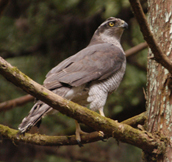
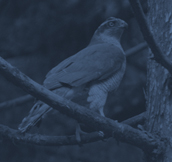 Accipiter gentilis (Goshawk) Accipitridae
Accipiter gentilis (Goshawk) Accipitridae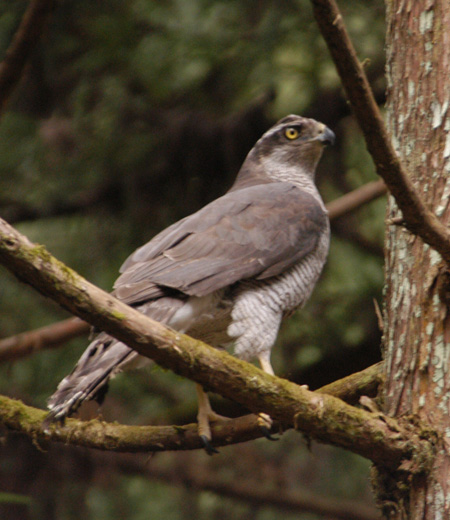 Found in forests from flatlands to mountains and also in cities. The body of adult birds is bluish gray and young birds are brown. Live alone except breeding season and hunt for pheasants, ducks, squirrels and wild rabbits. But feed on pigeons and crows in cities. The breeding season is from May to June. Build a large nest at the base of branches of large trees including pine trees and lay two to four eggs in a season. After egg hatches, male go hunting and give female preys by chirping “que que”. Re-use the same nest or use the same nest every two to three years.
Found in forests from flatlands to mountains and also in cities. The body of adult birds is bluish gray and young birds are brown. Live alone except breeding season and hunt for pheasants, ducks, squirrels and wild rabbits. But feed on pigeons and crows in cities. The breeding season is from May to June. Build a large nest at the base of branches of large trees including pine trees and lay two to four eggs in a season. After egg hatches, male go hunting and give female preys by chirping “que que”. Re-use the same nest or use the same nest every two to three years.
●Size male about 50 cm, female about 56 cm
●Season January to December(resident bird, bird that stay in the same area all year round, and wandering bird, bird that have different areas for breeding and spending winter) -
Butastur indicus (Gray-faced Buzzard-Eagle) Accipitridae

 Butastur indicus (Gray-faced Buzzard-Eagle) Accipitridae
Butastur indicus (Gray-faced Buzzard-Eagle) Accipitridae Found in forests, paddy fields and grasslands from flatlands to mountains. Fly back to Japan in spring from Southeast Asia where they spent winter. Hunt for preys including frogs, snakes, chicks, larvae, nymphs and rats in swamps and paddy fields. One of hawks chirp frequently and both male and female chirp “piqui” in high tones repeatedly. The breeding season is from May to June and builds a nest with layers of twigs and some with leaves. Lay two to four eggs in a season. From September to October, fly to south in groups. The group becomes larger about hundreds of them as they fly south. Cape Irako in Aichi prefecture and cape Sata in Kagoshima prefecture are places the group of this species pass by.
Found in forests, paddy fields and grasslands from flatlands to mountains. Fly back to Japan in spring from Southeast Asia where they spent winter. Hunt for preys including frogs, snakes, chicks, larvae, nymphs and rats in swamps and paddy fields. One of hawks chirp frequently and both male and female chirp “piqui” in high tones repeatedly. The breeding season is from May to June and builds a nest with layers of twigs and some with leaves. Lay two to four eggs in a season. From September to October, fly to south in groups. The group becomes larger about hundreds of them as they fly south. Cape Irako in Aichi prefecture and cape Sata in Kagoshima prefecture are places the group of this species pass by.
●Body Length about 49 cm
●Season April to October (Summer bird, fly to one area from spring to summer for breeding and fly back to southern areas in autumn.)(未翻訳)鳴き声を聞く
-
Buteo japonicus (Buzzard) Accipitridae
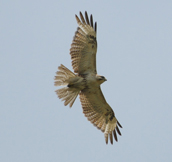
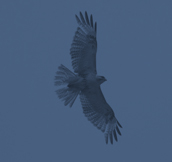 Buteo japonicus (Buzzard) Accipitridae
Buteo japonicus (Buzzard) Accipitridae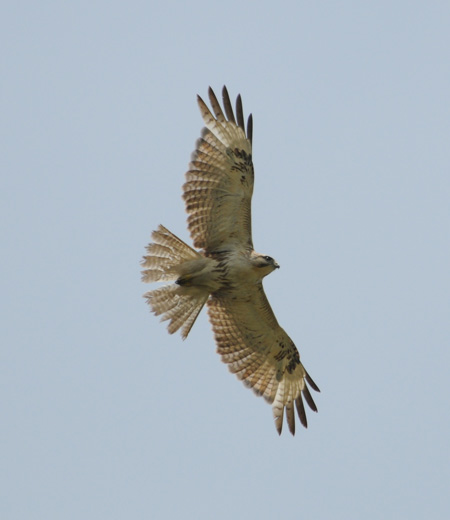 Is a mid-sized hawk found from flatlands to mountains. The body color for male and female is almost the same and white on chest. Live in forests near grasslands, croplands and pastures where they hunt. Feed mainly on rats and also snakes, frogs and birds. Like a black kite, soar upward with updraft and hunt for preys in the air. Also rest on the top of tall trees or stakes in croplands and hunt for preys. During breeding season, male and female chirp “pee eeh” like whistles. From May to June, build twigs over branches and some with leaves. Lay two to three eggs in a season. Tends to use the same nest every year.
Is a mid-sized hawk found from flatlands to mountains. The body color for male and female is almost the same and white on chest. Live in forests near grasslands, croplands and pastures where they hunt. Feed mainly on rats and also snakes, frogs and birds. Like a black kite, soar upward with updraft and hunt for preys in the air. Also rest on the top of tall trees or stakes in croplands and hunt for preys. During breeding season, male and female chirp “pee eeh” like whistles. From May to June, build twigs over branches and some with leaves. Lay two to three eggs in a season. Tends to use the same nest every year.
●Body Length about 55 cm
●Season January to December (resident bird, bird that stay in the same area all year round)(未翻訳)鳴き声を聞く
-
Strix uralensis (Ural Owl) Strigidae
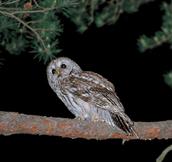
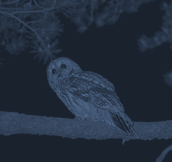 Strix uralensis (Ural Owl) Strigidae
Strix uralensis (Ural Owl) Strigidae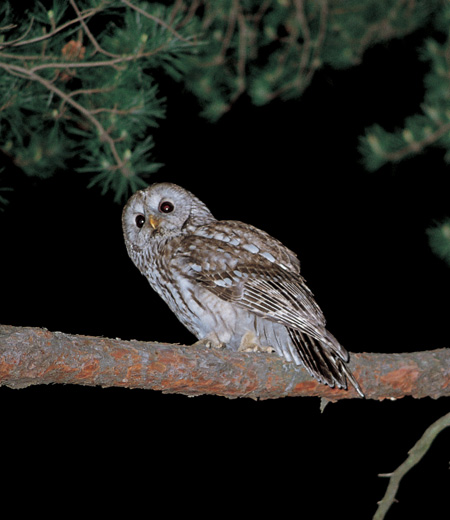 Live in forests and woods near resident area and live in shrines and temples in forests. Body color is the same for male and female. Body color varies by habitat. Are mostly gray and brown but become white in northern area. Live alone or in pairs and rest in shady forests and become active in late afternoon. Feed on rats, birds, lizards, frogs and insects. Hunt for these preys without flattering wings. Male and female chirp “ho ho” during breeding season. Build a nest in a hollow of large tree, ceilings of residence or shrines. Lay two to three eggs in a season from March to April.
Live in forests and woods near resident area and live in shrines and temples in forests. Body color is the same for male and female. Body color varies by habitat. Are mostly gray and brown but become white in northern area. Live alone or in pairs and rest in shady forests and become active in late afternoon. Feed on rats, birds, lizards, frogs and insects. Hunt for these preys without flattering wings. Male and female chirp “ho ho” during breeding season. Build a nest in a hollow of large tree, ceilings of residence or shrines. Lay two to three eggs in a season from March to April.
●Body Length about 50 cm
●Season January to December (resident bird, bird that stay in the same area all year round)(未翻訳)鳴き声を聞く
-
Ninox japonica (Brown Hawk Owl) Strigidae
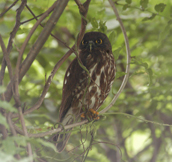
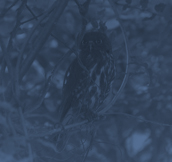 Ninox japonica (Brown Hawk Owl) Strigidae
Ninox japonica (Brown Hawk Owl) Strigidae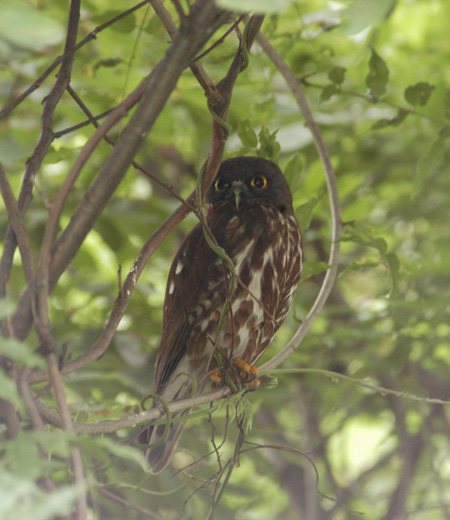 One of owls lives near residence area. Found on trees in cities, shrines and temples. The Japanese name Aobasuku literally meaning green leaves owls because they are seen from green season. The body color of male and female is almost the same, round-shaped head and dark brown face with gold eyes. Rest on trees during daytime and become active after chirping “hoot hoot” in pairs. Hunt for moths and gold beetles with foot and sometimes bats and small birds. The breeding season is from May to June, build a nest in tree hollows and spaces between buildings. Lay two to five eggs in a season. Female incubate eggs and male guard them. In autumn, fly to Southeast Asia to spend winter.
One of owls lives near residence area. Found on trees in cities, shrines and temples. The Japanese name Aobasuku literally meaning green leaves owls because they are seen from green season. The body color of male and female is almost the same, round-shaped head and dark brown face with gold eyes. Rest on trees during daytime and become active after chirping “hoot hoot” in pairs. Hunt for moths and gold beetles with foot and sometimes bats and small birds. The breeding season is from May to June, build a nest in tree hollows and spaces between buildings. Lay two to five eggs in a season. Female incubate eggs and male guard them. In autumn, fly to Southeast Asia to spend winter.
●Body Length about 29 cm
●Season May to October (Summer bird, fly to one area from spring to summer for breeding and fly back to southern areas in autumn.)(未翻訳)鳴き声を聞く
-
Alcedo atthis (Common Kingfisher) Alcedinidae
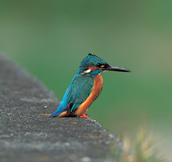
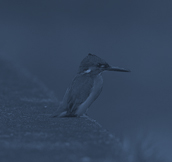 Alcedo atthis (Common Kingfisher) Alcedinidae
Alcedo atthis (Common Kingfisher) Alcedinidae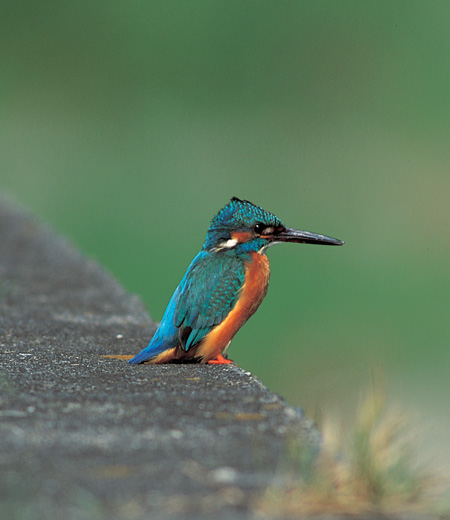 Have beautiful shiny cobalt blue wings and sometimes called jewel in stream. Also have distinct orange chest. The body color is the same for male and female but female have lower red bill. Found in bogs, rivers, lakes and ponds in mountains and also waterside in cities. Hold territory and live alone except breeding season. Target preys including fish, shrimps and aquatic insects from branches and stakes in water and jump to water to catch them. Male chases female chirping “chi chi pee” during breeding season. Nest by digging a hole in soil wall at waterside and lay five to seven eggs in a season.
Have beautiful shiny cobalt blue wings and sometimes called jewel in stream. Also have distinct orange chest. The body color is the same for male and female but female have lower red bill. Found in bogs, rivers, lakes and ponds in mountains and also waterside in cities. Hold territory and live alone except breeding season. Target preys including fish, shrimps and aquatic insects from branches and stakes in water and jump to water to catch them. Male chases female chirping “chi chi pee” during breeding season. Nest by digging a hole in soil wall at waterside and lay five to seven eggs in a season.
●Body Length about 17 cm
●Season January to December (resident bird, bird that stay in the same area all year round) -
Yungipicus kizuki (Japanese Pygmy Woodpecker) Picidae
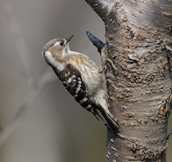
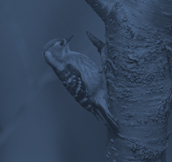 Yungipicus kizuki (Japanese Pygmy Woodpecker) Picidae
Yungipicus kizuki (Japanese Pygmy Woodpecker) Picidae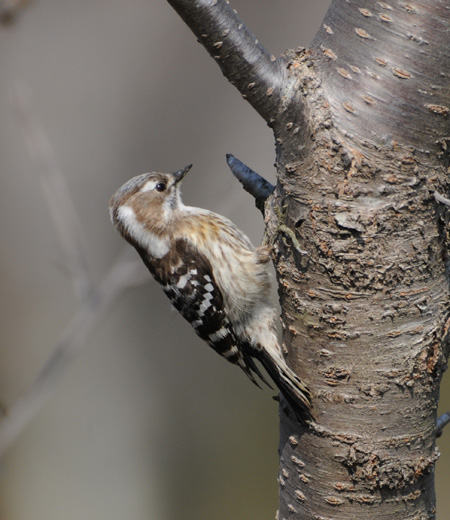 The smallest woodpecker found in Japan. The body color of male and female is almost the same but male have small red patterns on the back of head. Live in forests in mountains but sometimes breed at parks in cities. Live alone normally but come to residential area with a group of Japanese tit. Fly from trees to trees and hunt for insects and spiders and also feed on nectar of cherry blossoms by using tongues effectively. During breeding season, chirp “gee qui qui qi qi qi” and do drumming by tapping trees. Find half-dead trees and dig a hole and build a nest. Prefer trees of cherry blossoms and small mushrooms. From May to June, lay five eggs in a season.
The smallest woodpecker found in Japan. The body color of male and female is almost the same but male have small red patterns on the back of head. Live in forests in mountains but sometimes breed at parks in cities. Live alone normally but come to residential area with a group of Japanese tit. Fly from trees to trees and hunt for insects and spiders and also feed on nectar of cherry blossoms by using tongues effectively. During breeding season, chirp “gee qui qui qi qi qi” and do drumming by tapping trees. Find half-dead trees and dig a hole and build a nest. Prefer trees of cherry blossoms and small mushrooms. From May to June, lay five eggs in a season.
●Body Length about 15 cm
●Season January to December (resident bird, bird that stay in the same area all year round)(未翻訳)鳴き声を聞く
-
Dendrocopos major (Great Spotted Woodpecker) Picidae
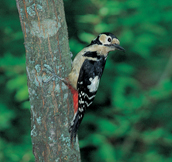
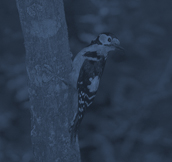 Dendrocopos major (Great Spotted Woodpecker) Picidae
Dendrocopos major (Great Spotted Woodpecker) Picidae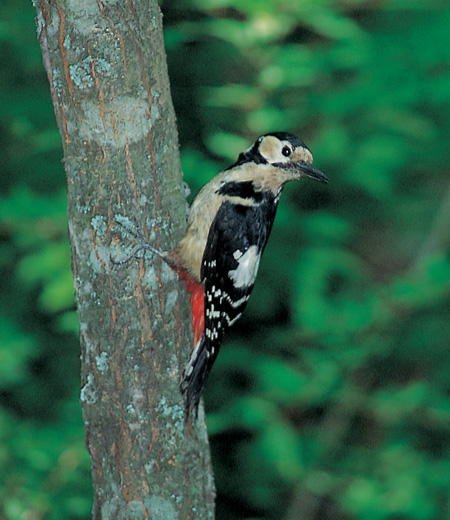 Live in forests from flatlands to mountains. Live alone or in pairs. Have distinct red feathers on the abdomen towards tails. The body color for male and female is almost the same but the back of head for male is red and black for female. Stay on the tree trunk vertically and pick up larvae and nymphs of insects from hollows of tree barks. Also feed on nuts of lacquer trees and crimson glory vine. Mostly stay in forests but sometimes hunt in low grasslands and croplands. Chirp “kyo kyo” normally but “quere quere” while flying. Often do drumming during breeding season. Build a nest in a hollow of fresh or dead Japanese red pine and white birch from May to July. Lay five to seven eggs in a season.
Live in forests from flatlands to mountains. Live alone or in pairs. Have distinct red feathers on the abdomen towards tails. The body color for male and female is almost the same but the back of head for male is red and black for female. Stay on the tree trunk vertically and pick up larvae and nymphs of insects from hollows of tree barks. Also feed on nuts of lacquer trees and crimson glory vine. Mostly stay in forests but sometimes hunt in low grasslands and croplands. Chirp “kyo kyo” normally but “quere quere” while flying. Often do drumming during breeding season. Build a nest in a hollow of fresh or dead Japanese red pine and white birch from May to July. Lay five to seven eggs in a season.
●Body Length about 24 cm
●Season January to December (resident bird, bird that stay in the same area all year round)(未翻訳)鳴き声を聞く
-
Picus awokera (Japanese Green Woodpecker) Picidae
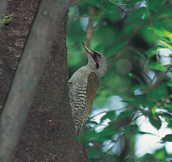
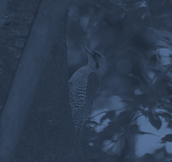 Picus awokera (Japanese Green Woodpecker) Picidae
Picus awokera (Japanese Green Woodpecker) Picidae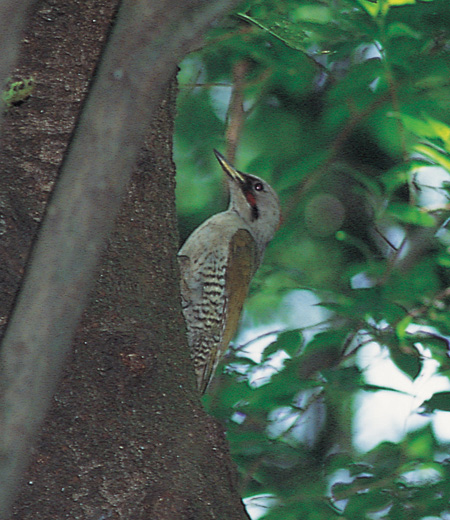 Is a woodpecker only live in Japan and found in forests from flatlands to mountains in south of Honshu area. Sometimes build a nest on cherry blossoms trees at parks in cities. The body color is grayish green with red on sides of a head and a bill. The body color for male and female is almost the same but male have larger red patterns and entire head is red. Fly from trees to trees by peck trunk of trees to catch insects and spiders and even ants on the ground. From autumn to winter, also feed on fruits and nuts of tree. The breeding season is from May to June. Chirp “pyo pyo” like whistles and do drumming. Nest in a tree by digging a with bill and lay seven to eight eggs in a season.
Is a woodpecker only live in Japan and found in forests from flatlands to mountains in south of Honshu area. Sometimes build a nest on cherry blossoms trees at parks in cities. The body color is grayish green with red on sides of a head and a bill. The body color for male and female is almost the same but male have larger red patterns and entire head is red. Fly from trees to trees by peck trunk of trees to catch insects and spiders and even ants on the ground. From autumn to winter, also feed on fruits and nuts of tree. The breeding season is from May to June. Chirp “pyo pyo” like whistles and do drumming. Nest in a tree by digging a with bill and lay seven to eight eggs in a season.
●Size about 29 cm
●Season January to December (resident bird, bird that stay in the same area all year round) -
Terpsiphone atrocaudata (Black Paradise Flycatcher) Monarchidae
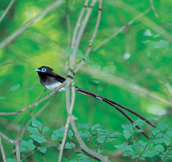
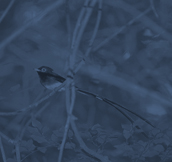 Terpsiphone atrocaudata (Black Paradise Flycatcher) Monarchidae
Terpsiphone atrocaudata (Black Paradise Flycatcher) Monarchidae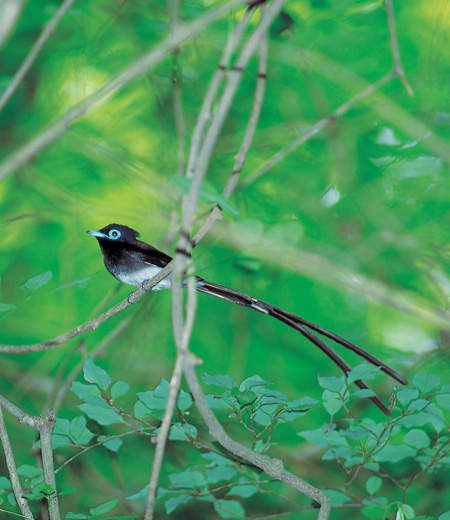 Fly back to Japan from Southeast Asia where they spent winter around April and breed in forests from flatlands to mountains. Chirp “two hee hoo shee hoi hoi” sounds like “Moon and star hoi hoi” for most of Japanese, hence the Japanese name is San-ko-chu literally meaning three lights birds. Around eyes and a bill is bright blue. Long tail is three times as large as body length for male and female have short tails. Are active in shady forets and hunt for insects and spiders in the air and at the tips of leaves. Build an upside down conical-shaped nest with moss, barks and threads of spiders. Lay three to five eggs in a season.
Fly back to Japan from Southeast Asia where they spent winter around April and breed in forests from flatlands to mountains. Chirp “two hee hoo shee hoi hoi” sounds like “Moon and star hoi hoi” for most of Japanese, hence the Japanese name is San-ko-chu literally meaning three lights birds. Around eyes and a bill is bright blue. Long tail is three times as large as body length for male and female have short tails. Are active in shady forets and hunt for insects and spiders in the air and at the tips of leaves. Build an upside down conical-shaped nest with moss, barks and threads of spiders. Lay three to five eggs in a season.
●Body Length Male about 45 cm, female about 18 cm
●Season April to August (Summer bird, fly to one area from spring to summer for breeding and fly back to southern areas in autumn.)(未翻訳)鳴き声を聞く
-
Lanius bucephalus (Bull-headed Shrike) Laniidae
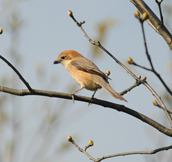
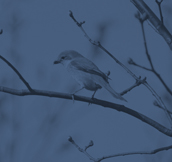 Lanius bucephalus (Bull-headed Shrike) Laniidae
Lanius bucephalus (Bull-headed Shrike) Laniidae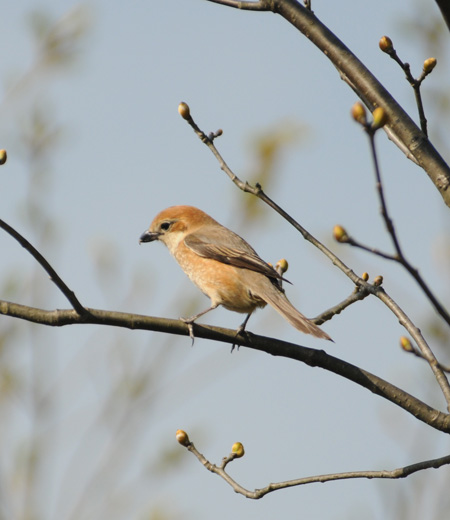 Found in open fields with shrubs or low trees. The color of the back is gray and have black eye stripes for male and female have scale-like patterns on chest to abdomen. Feed on insects and frogs and sometimes on small birds. Have an unique habit to pierce preys on twigs or thorns and called Mozu-no-hayanie literally meaning bull-headed shrike quickly cook. Are also good at chirping like other birds including Japanese white eyes. The breeding season is from March to August, start early compare to other birds. Some pairs raise birds twice in early spring and early summer. Build a cup-shaped nest with thin stems and vines on trees and lay four to six eggs each time. Live alone in autumn and hold territory by chirping “khi khili khili” sharply with high tones and fight occasionally.
Found in open fields with shrubs or low trees. The color of the back is gray and have black eye stripes for male and female have scale-like patterns on chest to abdomen. Feed on insects and frogs and sometimes on small birds. Have an unique habit to pierce preys on twigs or thorns and called Mozu-no-hayanie literally meaning bull-headed shrike quickly cook. Are also good at chirping like other birds including Japanese white eyes. The breeding season is from March to August, start early compare to other birds. Some pairs raise birds twice in early spring and early summer. Build a cup-shaped nest with thin stems and vines on trees and lay four to six eggs each time. Live alone in autumn and hold territory by chirping “khi khili khili” sharply with high tones and fight occasionally.
●Body Length about 20 cm
●Season January to December (resident bird, bird that stay in the same area all year round, and wandering bird, bird that have different areas for breeding and spending winter) -
Garrulus glandarius (Eurasian Jay) Corvidae
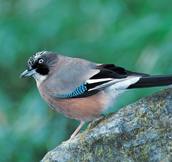
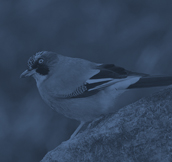 Garrulus glandarius (Eurasian Jay) Corvidae
Garrulus glandarius (Eurasian Jay) Corvidae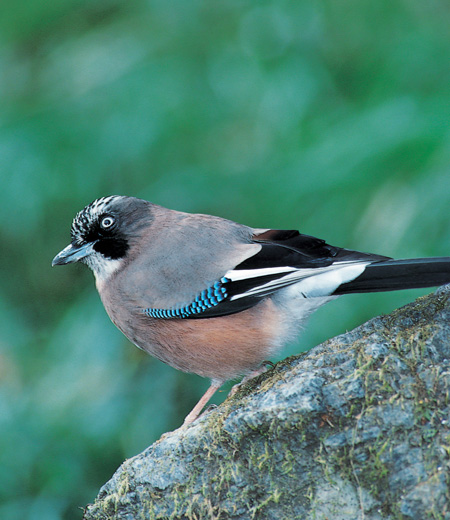 The body color of male and female is the same and brown on body with white and black patterns on head. Wings with black, blue and white patterns are distinct while flying. Found in shady forests from flatlands to mountains and live in a small group except breeding season. Walk like jumping on the ground or on trees and feed on insects, lizards and nuts of trees. The favorite food is acorns and sometimes hides them in hollows of trees or in soils. Chirp “Jyee Jyee“ with husky voice but good at pretending hawks and small birds. The breeding season is from April to June, build a nest at the base of branches and lay five to six eggs in a season.
The body color of male and female is the same and brown on body with white and black patterns on head. Wings with black, blue and white patterns are distinct while flying. Found in shady forests from flatlands to mountains and live in a small group except breeding season. Walk like jumping on the ground or on trees and feed on insects, lizards and nuts of trees. The favorite food is acorns and sometimes hides them in hollows of trees or in soils. Chirp “Jyee Jyee“ with husky voice but good at pretending hawks and small birds. The breeding season is from April to June, build a nest at the base of branches and lay five to six eggs in a season.
●Body Length about 33 cm
●Season January to December (resident bird, bird that stay in the same area all year round) -
Cyanopica cyana (Azure-winged Magpie) Corvidae
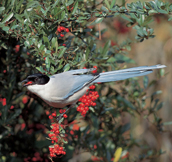
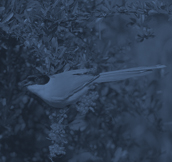 Cyanopica cyana (Azure-winged Magpie) Corvidae
Cyanopica cyana (Azure-winged Magpie) Corvidae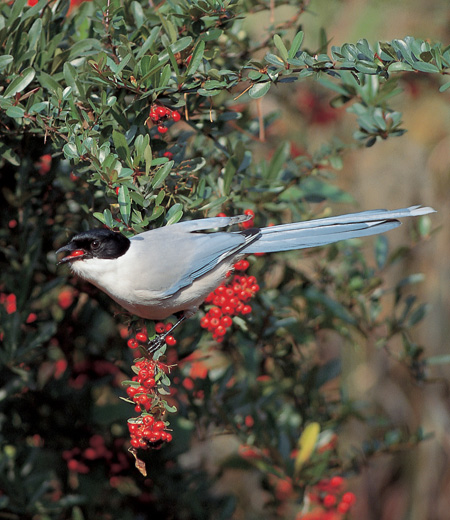 Is a most frequently found crow in forests and residential areas. Chirp very loudly “caw caw caw” at where baits are placed. The body color for male and female is almost the same and have round-shaped head as if they have a hat on. Wings and long tail are bluish gray and have white chest and neck. Is in a small group and patrol the same route and hunt for preys. When one moves, others follow. Walk like jumping on trees and on the ground and hunt for insects, nuts of trees and fruits and sometimes for small birds or chicks. Hunt for preys in the early morning and late afternoon at parks and gardens and stay in forests during daytime. The breeding season is from May to August and crates a nest with layers of twigs in woods or street trees and lay seven to eight eggs in a season.
Is a most frequently found crow in forests and residential areas. Chirp very loudly “caw caw caw” at where baits are placed. The body color for male and female is almost the same and have round-shaped head as if they have a hat on. Wings and long tail are bluish gray and have white chest and neck. Is in a small group and patrol the same route and hunt for preys. When one moves, others follow. Walk like jumping on trees and on the ground and hunt for insects, nuts of trees and fruits and sometimes for small birds or chicks. Hunt for preys in the early morning and late afternoon at parks and gardens and stay in forests during daytime. The breeding season is from May to August and crates a nest with layers of twigs in woods or street trees and lay seven to eight eggs in a season.
●Body Length about 37 cm
●Season January to December (resident bird, bird that stay in the same area all year round) -
Corvus Corone (Carrion crow) Corvidae
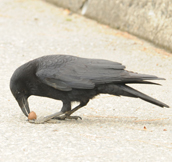
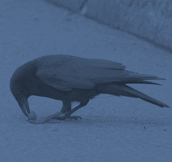 Corvus Corone (Carrion crow) Corvidae
Corvus Corone (Carrion crow) Corvidae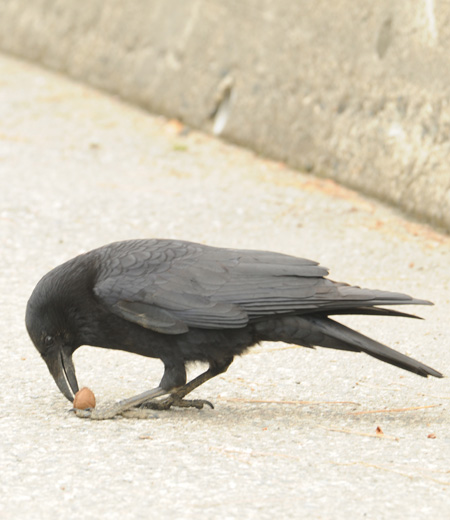 Found in forests from flatlands to low elevations, croplands and cities. Compare to jungle crow, this species have more round-shaped head and thin bill. Chirp “cow cow” while moving head downward like bowing, and some species chirp sounding like “capon capon” or “ca la la la”. Are normally in a group except breeding season. Fly to areas where they can hunt for preys including croplands and riverbeds from early in the morning and come back to the same place to rest. Are omnivorous and feed on earthworms, frogs, fish, bugs, seeds of plants and nuts of trees and also raiding garbage in cities. Are attracted to objects that reflect lights and often take golf balls away from golf course. The breeding season is from March to May. Build a ball-shaped nest at the upper parts of trees with twigs and lay three to six eggs in a season.
Found in forests from flatlands to low elevations, croplands and cities. Compare to jungle crow, this species have more round-shaped head and thin bill. Chirp “cow cow” while moving head downward like bowing, and some species chirp sounding like “capon capon” or “ca la la la”. Are normally in a group except breeding season. Fly to areas where they can hunt for preys including croplands and riverbeds from early in the morning and come back to the same place to rest. Are omnivorous and feed on earthworms, frogs, fish, bugs, seeds of plants and nuts of trees and also raiding garbage in cities. Are attracted to objects that reflect lights and often take golf balls away from golf course. The breeding season is from March to May. Build a ball-shaped nest at the upper parts of trees with twigs and lay three to six eggs in a season.
●Body Length about 50 cm
●Season January to December (resident bird, bird that stay in the same area all year round.) -
Corvus macrorhynchos (Jungle Crow) Corvidae
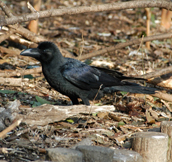
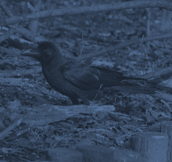 Corvus macrorhynchos (Jungle Crow) Corvidae
Corvus macrorhynchos (Jungle Crow) Corvidae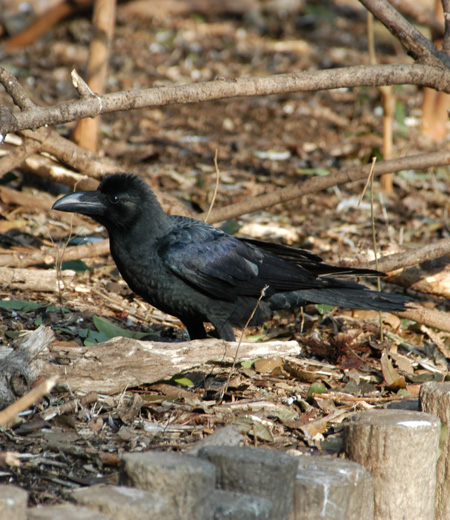 Found in mountains, coasts, riverbeds, croplands, town and even office areas in cities. Compare to corvus corone, the head is volumy and bill is thick and big. Have a habit of chasing hawks and owls. Caw with clear toned voice and sometimes make voice resembling human being laughing. Are normally in a group except breeding season and go back to the same place rest at night. Are omnivorous and feed on wide varieties of preys. Also raid garbage and feed on dead animals. Build a nest on tree but sometimes on electric poles or steel towers with branches and various items including wires, hangers and plastic threads. The breeding season is from March to May and lay four to five eggs in a season.
Found in mountains, coasts, riverbeds, croplands, town and even office areas in cities. Compare to corvus corone, the head is volumy and bill is thick and big. Have a habit of chasing hawks and owls. Caw with clear toned voice and sometimes make voice resembling human being laughing. Are normally in a group except breeding season and go back to the same place rest at night. Are omnivorous and feed on wide varieties of preys. Also raid garbage and feed on dead animals. Build a nest on tree but sometimes on electric poles or steel towers with branches and various items including wires, hangers and plastic threads. The breeding season is from March to May and lay four to five eggs in a season.
●Body Length about 57 cm
●Seasons January to December (resident bird, bird that stay in the same area all year round.) -
Regulus regulus (Goldcrest) Regulidae
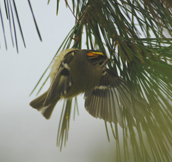
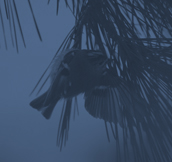 Regulus regulus (Goldcrest) Regulidae
Regulus regulus (Goldcrest) Regulidae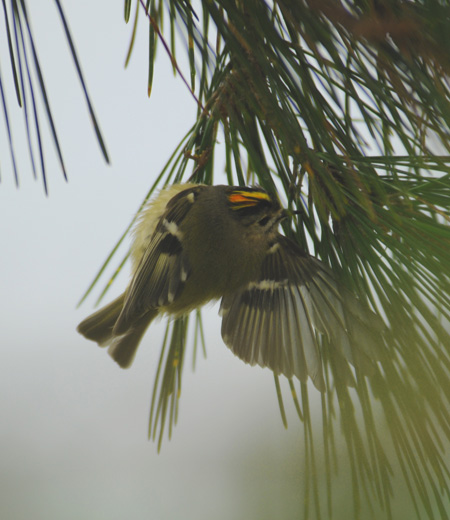 Is one of the small birds in Japan like wren and weight about 5 to 6 grams. Have chrysanthemum-like yellow feathers on the head, hence the Japanese name Kiku-itadaki literally meaning chrysanthemum on a head. The body color of male and female is almost the same but male have red line on the head. Live on needle-leaved trees including pine trees and Japanese cypress and move frequently among trees and hunt for bugs and spiders. Live mostly on trees and come down to the ground only for bathing. Chirp sounding like “tu li li li tzee” with metallic and thin tones. The breeding season is from June to July. Build a ball-shaped nest with moss and spider’s thread on a branch and lay five to eight eggs in a season. From autumn to winter, move to flatlands to low elevations and are in a group with coal tit.
Is one of the small birds in Japan like wren and weight about 5 to 6 grams. Have chrysanthemum-like yellow feathers on the head, hence the Japanese name Kiku-itadaki literally meaning chrysanthemum on a head. The body color of male and female is almost the same but male have red line on the head. Live on needle-leaved trees including pine trees and Japanese cypress and move frequently among trees and hunt for bugs and spiders. Live mostly on trees and come down to the ground only for bathing. Chirp sounding like “tu li li li tzee” with metallic and thin tones. The breeding season is from June to July. Build a ball-shaped nest with moss and spider’s thread on a branch and lay five to eight eggs in a season. From autumn to winter, move to flatlands to low elevations and are in a group with coal tit.
●Body Length about 10 cm
●Season January to December (resident bird, bird that stay in the same area all year round.)(未翻訳)鳴き声を聞く
-
Parus montanus (Willow Tit) Paridae
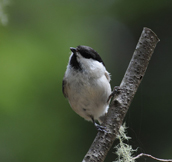
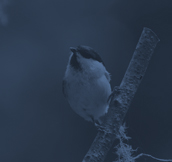 Parus montanus (Willow Tit) Paridae
Parus montanus (Willow Tit) Paridae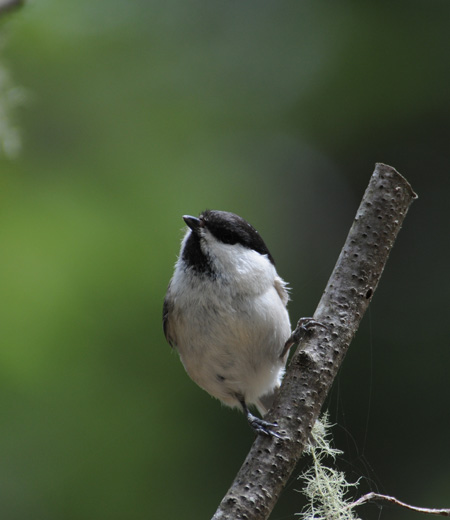 Many are found in forests in mountains over 1,500 meters elevations but some are in low elevations. The body color of male and female is almost the same, black on the head, light brown on the back and white on cheek and abdomen. Live in groups around broad-leaved trees including quercus serrata and maple trees. Catch bugs and spiders by pecking branches and trunk of trees and also feed on seeds of plants and nuts of trees. Have a habit of hiding nuts of tree in hollows of trees. The breeding season is from May to July. Male chirp slowly sounding like “ hitcho ci choo” and “tu pi tu pi tu pi” for announcing their territory. Nest by digging a hole in half-dead tree and cover the floor with soft materials like soften barks. Lay five to eight eggs in a sesason. In winter, many of them are in a group with birds in paridae family.
Many are found in forests in mountains over 1,500 meters elevations but some are in low elevations. The body color of male and female is almost the same, black on the head, light brown on the back and white on cheek and abdomen. Live in groups around broad-leaved trees including quercus serrata and maple trees. Catch bugs and spiders by pecking branches and trunk of trees and also feed on seeds of plants and nuts of trees. Have a habit of hiding nuts of tree in hollows of trees. The breeding season is from May to July. Male chirp slowly sounding like “ hitcho ci choo” and “tu pi tu pi tu pi” for announcing their territory. Nest by digging a hole in half-dead tree and cover the floor with soft materials like soften barks. Lay five to eight eggs in a sesason. In winter, many of them are in a group with birds in paridae family.
●Body Length about 13 cm
●Season January to December (resident bird, bird that stay in the same area all year round.)(未翻訳)鳴き声を聞く
-
Sittiparus varius (Varied Tit) Paridae
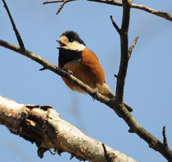
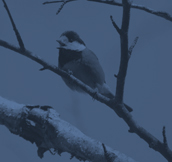 Sittiparus varius (Varied Tit) Paridae
Sittiparus varius (Varied Tit) Paridae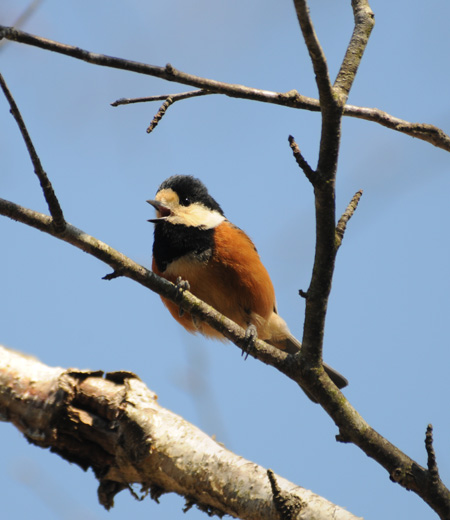 Found in forests from flatlands to low elevations and live around evergreen broad-leaved forests including camphor laurel and oak trees. They often come to residential areas. Live alone or in a small group except breeding season but some do stay in pairs throughout a year. The body color of male and female is almost the same with distinct bluish gray wings and nut-brown back and abdomen. Feed on bugs and nuts of trees. The favorite food is an acorn and holds them with legs and cracks them with bill to eat. Have a habit of hiding and storing acorns in hollows of trees or in soils for winter. The breeding season is from April to July and male chirps sounding like “tu tu pee tu pee”. Re-use the nest of woodpeckers or bird box and lay five to eight eggs in a season.
Found in forests from flatlands to low elevations and live around evergreen broad-leaved forests including camphor laurel and oak trees. They often come to residential areas. Live alone or in a small group except breeding season but some do stay in pairs throughout a year. The body color of male and female is almost the same with distinct bluish gray wings and nut-brown back and abdomen. Feed on bugs and nuts of trees. The favorite food is an acorn and holds them with legs and cracks them with bill to eat. Have a habit of hiding and storing acorns in hollows of trees or in soils for winter. The breeding season is from April to July and male chirps sounding like “tu tu pee tu pee”. Re-use the nest of woodpeckers or bird box and lay five to eight eggs in a season.
●Body Length about 14 cm
●Season January to December (resident bird, bird that stay in the same area all year round.)(未翻訳)鳴き声を聞く
-
Parus ater (Coal Tit) Paridae
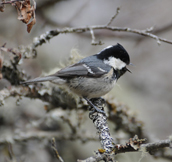
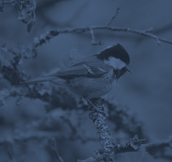 Parus ater (Coal Tit) Paridae
Parus ater (Coal Tit) Paridae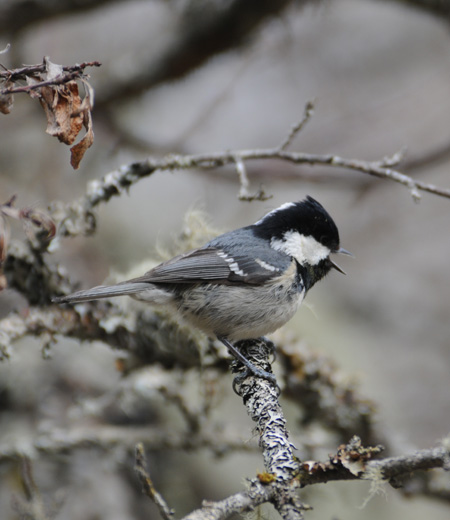 Is the smallest bird in a paridae family. This species, willow tit and Japanese tit are very similar but this species have small crown-like feathers on black head. This is where to identify this species from others. Found in forests from flatlands to mountains. Live on trees and jump to branches and leaves and feed on bugs, spiders, seeds of plants and nuts of trees. The breeding season is from May to June and chirp sounding like “tu tutee tu lili” with thin and high tones to inform own territory. Build a nest in holes of trees, old nest of woodpecker or a bird box cover the floor with hair of animals and moss. Lay five to eight eggs in a season. Are in a small group with other birds in paridae family except breeding season.
Is the smallest bird in a paridae family. This species, willow tit and Japanese tit are very similar but this species have small crown-like feathers on black head. This is where to identify this species from others. Found in forests from flatlands to mountains. Live on trees and jump to branches and leaves and feed on bugs, spiders, seeds of plants and nuts of trees. The breeding season is from May to June and chirp sounding like “tu tutee tu lili” with thin and high tones to inform own territory. Build a nest in holes of trees, old nest of woodpecker or a bird box cover the floor with hair of animals and moss. Lay five to eight eggs in a season. Are in a small group with other birds in paridae family except breeding season.
●Body Length about 11 cm
●Season January to December (resident bird, bird that stay in the same area all year round.) -
Parus cinereus (Japanese Tit) Paridae
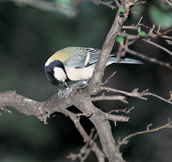
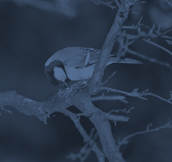 Parus cinereus (Japanese Tit) Paridae
Parus cinereus (Japanese Tit) Paridae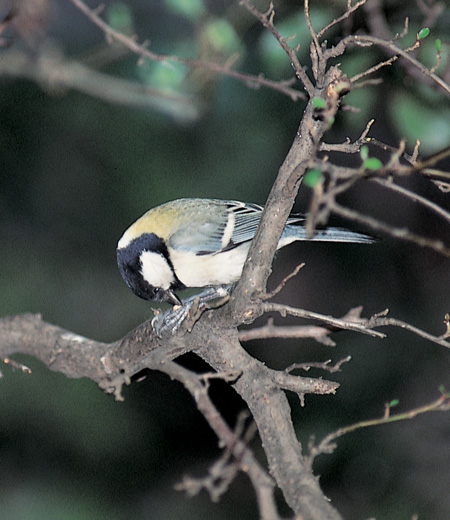 Have a distinct black tie-like pattern from throat to chest. The body color of male and female is almost the same but this pattern on male is wider than the one on female. Found in forests from flatlands to mountains and even at parks in residential areas. Are not afraid of human being and build a nest in letter boxes at houses or flower pots at gardens. Hunt for bugs and spiders on trees or on the ground and also feed on seeds of plants. Often come to feeding stations. Their favorite is sunflower seeds. Male chirps sounding like “tu tu pee tu tu pee” during breeding season. Nest in a hole or space between rocks but often use bird’s box. Lay seven to ten eggs from April to July.
Have a distinct black tie-like pattern from throat to chest. The body color of male and female is almost the same but this pattern on male is wider than the one on female. Found in forests from flatlands to mountains and even at parks in residential areas. Are not afraid of human being and build a nest in letter boxes at houses or flower pots at gardens. Hunt for bugs and spiders on trees or on the ground and also feed on seeds of plants. Often come to feeding stations. Their favorite is sunflower seeds. Male chirps sounding like “tu tu pee tu tu pee” during breeding season. Nest in a hole or space between rocks but often use bird’s box. Lay seven to ten eggs from April to July.
●Body Length about 15 cm
●Season January to December (resident bird, bird that stay in the same area all year round.)(未翻訳)鳴き声を聞く
-
Hirundo rustica (Barn Swallow) Hirundinidae
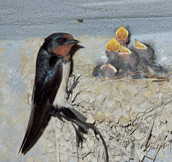
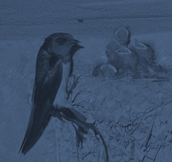 Hirundo rustica (Barn Swallow) Hirundinidae
Hirundo rustica (Barn Swallow) Hirundinidae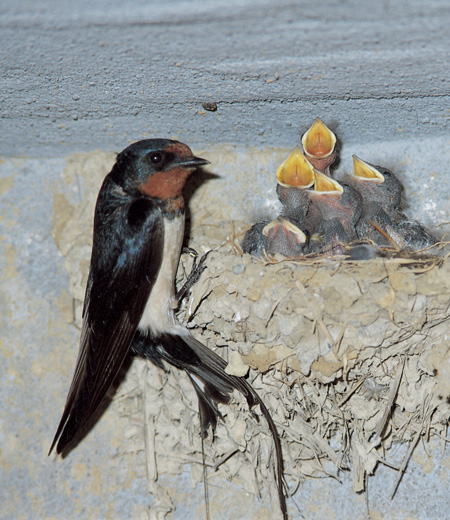 Fly back to Japan in early spring from Southeast Asia where they spent winter. Is the most commonly known bird nest on the walls right near the ceiling. Live in open croplands, paddy fields and waterside and often seen in cities. Fly low over croplands and catch flying bugs and drink water like scooping them during the flight. Live in pairs during breeding season and often fly back and forth from the nest to paddy fields and riverbeds to collects muds and dried leaves for building a nest. From April to July, lay one egg per day and three to seven eggs in total in a season. After nestling, move to grasslands with common reeds grow and live with a small group. In autumn, fly to south.
Fly back to Japan in early spring from Southeast Asia where they spent winter. Is the most commonly known bird nest on the walls right near the ceiling. Live in open croplands, paddy fields and waterside and often seen in cities. Fly low over croplands and catch flying bugs and drink water like scooping them during the flight. Live in pairs during breeding season and often fly back and forth from the nest to paddy fields and riverbeds to collects muds and dried leaves for building a nest. From April to July, lay one egg per day and three to seven eggs in total in a season. After nestling, move to grasslands with common reeds grow and live with a small group. In autumn, fly to south.
●Body Length about 17 cm
●Season March to about October (Summer bird, fly to one area from spring to summer for breeding and fly back to southern areas in autumn.) -
Delichon urbica (Asian House Martin) Hirundinidae
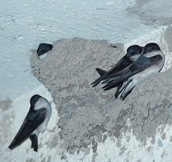
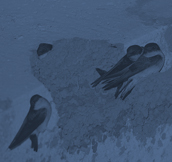 Delichon urbica (Asian House Martin) Hirundinidae
Delichon urbica (Asian House Martin) Hirundinidae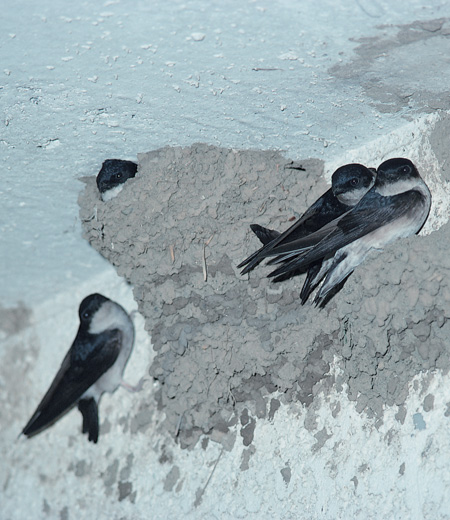 Fly back to Japan in the earliest time in spring from Southeast Asia. Body size is small and tail is short compare to house sparrow. Whereas house sparrow have red-brown rom face to throat, but this species have white throat. Live in a group in open fields from flatlands to high elevations. Catch mosquitos, moths and flies during the flight. Are used to nest in a group on rocky hills or caves along coasts but now below ceilings of building, stations, bridges and houses in cities as they are increased in number. Male chirp sounding like “pi li jyu li chi” during breeding season. Build a pot-shaped nest shaping muds and dry leaves with saliva and lay three to four eggs in a season.
Fly back to Japan in the earliest time in spring from Southeast Asia. Body size is small and tail is short compare to house sparrow. Whereas house sparrow have red-brown rom face to throat, but this species have white throat. Live in a group in open fields from flatlands to high elevations. Catch mosquitos, moths and flies during the flight. Are used to nest in a group on rocky hills or caves along coasts but now below ceilings of building, stations, bridges and houses in cities as they are increased in number. Male chirp sounding like “pi li jyu li chi” during breeding season. Build a pot-shaped nest shaping muds and dry leaves with saliva and lay three to four eggs in a season.
●Body Length about 15 cm
●Season March to about Octobers (Summer bird, fly to one area from spring to summer for breeding and fly back to southern areas in autumn.) -
Hypsipetes amaurotis (Brown-eared Bulbul) Pycnonotidae
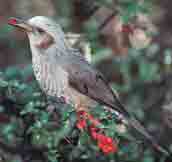
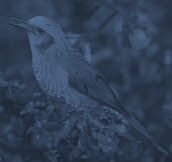 Hypsipetes amaurotis (Brown-eared Bulbul) Pycnonotidae
Hypsipetes amaurotis (Brown-eared Bulbul) Pycnonotidae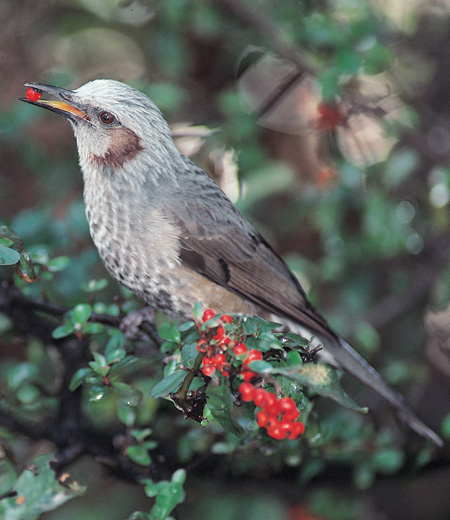 Found in forests from flatlands to mountains and also often seen in cities. Chirp loudly sounding like “hi hi heeyo heeyo”, hence the Japanese name Hiyo-dori. Mostly live on trees and hardly ever come down to the ground. Feed on fruits, nuts of trees, flowers, nectar, insects, chicks and lizards. Originally raise chicks from spring to summer in mountains and come to warm flatlands from autumn to winter but more and more species do live in cities or at parks throughout a year. The breeding season is from May to July. Build a nest with dead leaves and twigs and lay four to five eggs in a season. Sometimes plastic threads are used to build a nest. Are in a group of hundreds and fly short distance to the warmer areas (change habitats by season).
Found in forests from flatlands to mountains and also often seen in cities. Chirp loudly sounding like “hi hi heeyo heeyo”, hence the Japanese name Hiyo-dori. Mostly live on trees and hardly ever come down to the ground. Feed on fruits, nuts of trees, flowers, nectar, insects, chicks and lizards. Originally raise chicks from spring to summer in mountains and come to warm flatlands from autumn to winter but more and more species do live in cities or at parks throughout a year. The breeding season is from May to July. Build a nest with dead leaves and twigs and lay four to five eggs in a season. Sometimes plastic threads are used to build a nest. Are in a group of hundreds and fly short distance to the warmer areas (change habitats by season).
●Body Length about 28 cm
●Season January to December (resident bird, bird that stay in the same area all year round.) -
Horornis diphone (Bush Warbler) Cettiidae
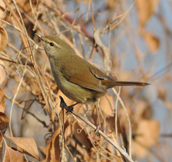
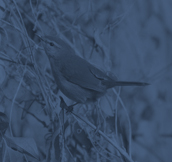 Horornis diphone (Bush Warbler) Cettiidae
Horornis diphone (Bush Warbler) Cettiidae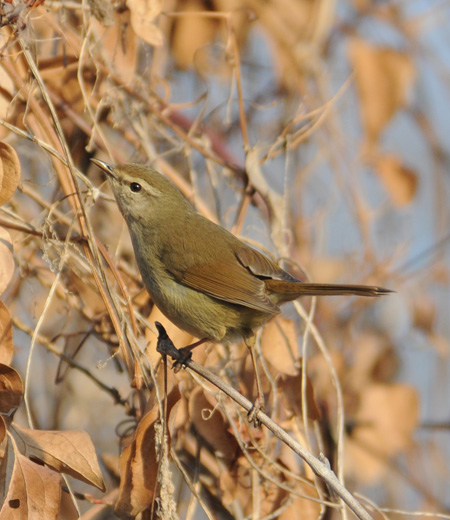 Are famous for their chirp sounding like ”Hō-hoke-kyo”. This is a male announcing own territory. Except this season and female normally chirp sounding like “cha cha cha”. Found in shrubs, forests and grasslands from flatlands to mountains and sometimes at parks in cities. The body color of male and female is almost the same, with grayish green body and light gray belt-like pattern above eyes. Live normally alone except breeding season and feed on bugs and spiders and fruits including persimmons. Rest placing a body horizontally to branches and change where they are looking by moving tails with rhythm. Fly in shrubs but does not fly long distance. The breeding season is from April to August. Build a ball-shaped nest with sasa leaves and dead Japanese pampas grass and lay four to six eggs in a season.
Are famous for their chirp sounding like ”Hō-hoke-kyo”. This is a male announcing own territory. Except this season and female normally chirp sounding like “cha cha cha”. Found in shrubs, forests and grasslands from flatlands to mountains and sometimes at parks in cities. The body color of male and female is almost the same, with grayish green body and light gray belt-like pattern above eyes. Live normally alone except breeding season and feed on bugs and spiders and fruits including persimmons. Rest placing a body horizontally to branches and change where they are looking by moving tails with rhythm. Fly in shrubs but does not fly long distance. The breeding season is from April to August. Build a ball-shaped nest with sasa leaves and dead Japanese pampas grass and lay four to six eggs in a season.
●Body Length about 15 cm
●Season January to December (resident bird, bird that stay in the same area all year round.) or nomadic bird)(未翻訳)鳴き声を聞く
-
Cettia squameiceps (Short-tailed Bush Warbler) Cettiidae
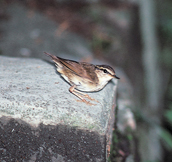
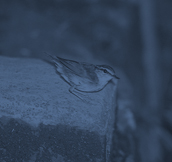 Cettia squameiceps (Short-tailed Bush Warbler) Cettiidae
Cettia squameiceps (Short-tailed Bush Warbler) Cettiidae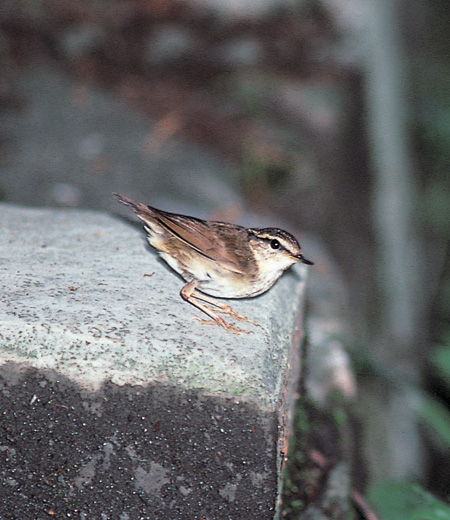 Fly back to Japan in spring from Southeast Asia where they spent winter. It is difficult to find as they live in shady forests with sasa leaves and hardly ever come out from there. Live alone except breeding season and walk and jump around to hunt for bugs and spiders just like rats do. The body color of male and female is almost the same with brown body, cocoon like white belt-like patterns and have short tail. The breeding season is from May to July and male chirp sounding like ”shin shin shin” like insects and for alerting, “cha cha” in own territory. Build a cup-shaped nest with moss and fallen leaves at the roots of trees and dip on the ground and lay five to seven eggs in a season. In autumn after nestling, fly to south.
Fly back to Japan in spring from Southeast Asia where they spent winter. It is difficult to find as they live in shady forests with sasa leaves and hardly ever come out from there. Live alone except breeding season and walk and jump around to hunt for bugs and spiders just like rats do. The body color of male and female is almost the same with brown body, cocoon like white belt-like patterns and have short tail. The breeding season is from May to July and male chirp sounding like ”shin shin shin” like insects and for alerting, “cha cha” in own territory. Build a cup-shaped nest with moss and fallen leaves at the roots of trees and dip on the ground and lay five to seven eggs in a season. In autumn after nestling, fly to south.
●Body Length about 11 cm
●Season April to September (Summer bird, fly to one area from spring to summer for breeding and fly back to southern areas in autumn) -
Aegithalos caudatus (Long-tailed Tit) Aegithalidae
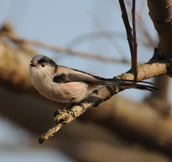
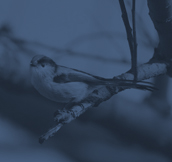 Aegithalos caudatus (Long-tailed Tit) Aegithalidae
Aegithalos caudatus (Long-tailed Tit) Aegithalidae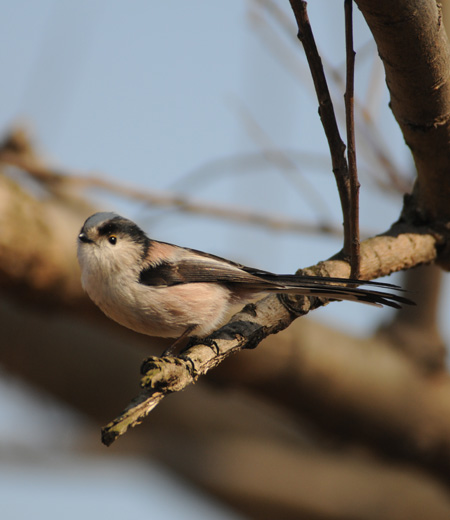 This species have the shortest bill in Japan. Have a small roundy body with distinct long tail. The body color of male and female is almost the same, white head with black belt above eyes and light purple color on shoulders. Live in pine tree forests from flatlands to mountains and also in woody residential areas and at parks. Chirp sounding like “ju li ju li tu li li chee chee” regardless of season. Live in a small group except breeding season and some are with other birds such as great tit. Feed on bugs, spiders and nuts of trees on branches and also on sap of maple trees in early spring. The breeding season is from February to June. Build a oval-shaped nest with twigs, spider’s thread and moss and lay seven to twelve eggs in a season.
This species have the shortest bill in Japan. Have a small roundy body with distinct long tail. The body color of male and female is almost the same, white head with black belt above eyes and light purple color on shoulders. Live in pine tree forests from flatlands to mountains and also in woody residential areas and at parks. Chirp sounding like “ju li ju li tu li li chee chee” regardless of season. Live in a small group except breeding season and some are with other birds such as great tit. Feed on bugs, spiders and nuts of trees on branches and also on sap of maple trees in early spring. The breeding season is from February to June. Build a oval-shaped nest with twigs, spider’s thread and moss and lay seven to twelve eggs in a season.
●Body Length about 14 cm
●Season January to December (resident bird, bird that stay in the same area all year round.) -
Phylloscopus occipitalis (Crowned Willow Warbler) Phylloscopidae
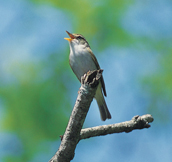
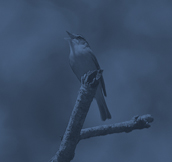 Phylloscopus occipitalis (Crowned Willow Warbler) Phylloscopidae
Phylloscopus occipitalis (Crowned Willow Warbler) Phylloscopidae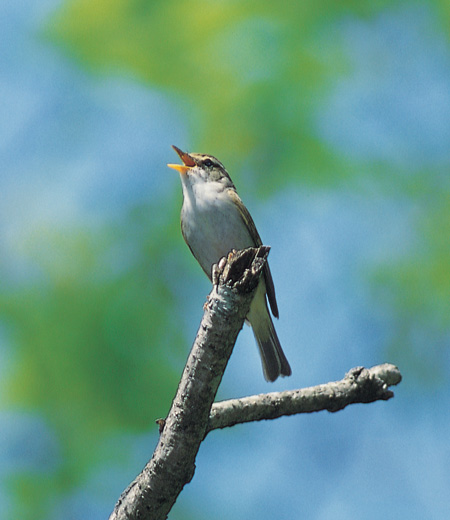 Fly back to Japan in spring from Southeast Asia where they spent winter. Live in broad-leaved forests including quercus serrate and maple trees in low elevations but found them at parks and residential areas from spring and autumn. The body color of male and female is almost the same and dark green from head to back with white cocoon like long line. Move frequently on branches and feed on bugs and spiders on leaves and branches. The breeding season is May to June and chirp sounding like “cho cho bee” on trees, also sounding like “sho-chu-ippai-gubi” in Japanese (one more cup of shochu). Build a ball-shaped nest with the entrance is tilted open by collecting fallen leaves and plants. Lay five to six eggs in a season.
Fly back to Japan in spring from Southeast Asia where they spent winter. Live in broad-leaved forests including quercus serrate and maple trees in low elevations but found them at parks and residential areas from spring and autumn. The body color of male and female is almost the same and dark green from head to back with white cocoon like long line. Move frequently on branches and feed on bugs and spiders on leaves and branches. The breeding season is May to June and chirp sounding like “cho cho bee” on trees, also sounding like “sho-chu-ippai-gubi” in Japanese (one more cup of shochu). Build a ball-shaped nest with the entrance is tilted open by collecting fallen leaves and plants. Lay five to six eggs in a season.
●Body Length about 13 cm
●Season April to September (Summer bird, fly to one area from spring to summer for breeding and fly back to southern areas in autumn.) -
Zosterops japonica (Japanese White-eye) Zosteropidae
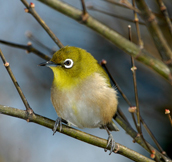
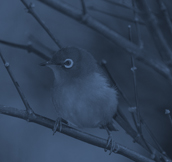 Zosterops japonica (Japanese White-eye) Zosteropidae
Zosterops japonica (Japanese White-eye) Zosteropidae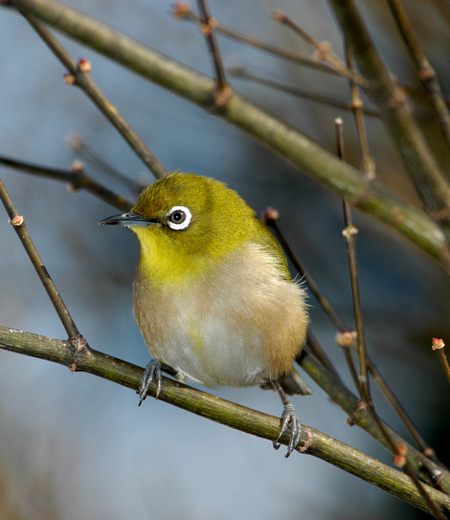 Found in forests from flatlands to low elevations and also at parks, gardens and backyards of residence. The body color of male and female is almost the same and have yellow-green from head to the back and distinct ring of white feathers around eyes. Most of them live in pairs throughout a year and move frequently among trees and hunt for spiders and plant louses. Also likes nectar and pollen of flowers and fly to camellia, cherry blossoms and Japanese ume flowers for nectar and pollen. At these tree, the face of this species are covered with pollen, thus they have the role of pollinating. The breeding season is from April to June. Build a cup-shaped nest with moss and stems of plants glued with spider’s threads. Lay three to five eggs in a season.
Found in forests from flatlands to low elevations and also at parks, gardens and backyards of residence. The body color of male and female is almost the same and have yellow-green from head to the back and distinct ring of white feathers around eyes. Most of them live in pairs throughout a year and move frequently among trees and hunt for spiders and plant louses. Also likes nectar and pollen of flowers and fly to camellia, cherry blossoms and Japanese ume flowers for nectar and pollen. At these tree, the face of this species are covered with pollen, thus they have the role of pollinating. The breeding season is from April to June. Build a cup-shaped nest with moss and stems of plants glued with spider’s threads. Lay three to five eggs in a season.
●Body Length about 12 cm
●Season January to December (resident bird, bird that stay in the same area all year round.) -
Bombycilla garrulous (Bohemian Waxwing) Bombycillidae
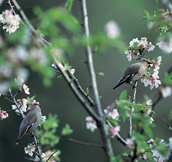
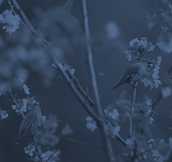 Bombycilla garrulous (Bohemian Waxwing) Bombycillidae
Bombycilla garrulous (Bohemian Waxwing) Bombycillidae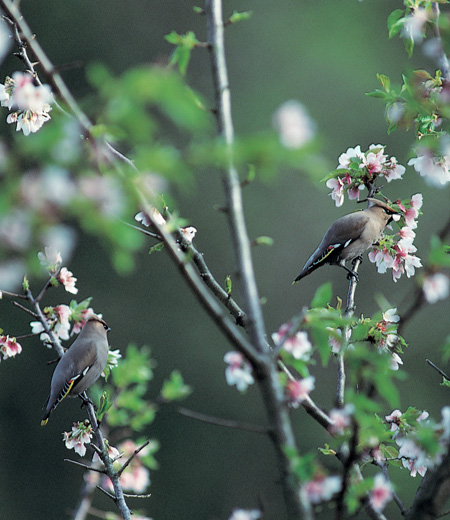 Come back to Japan from breeding ground in Siberia to spent winter. Fly to forests in flatlands to mountains in Japan around October. Live mostly in northern Japan and in Hokkaido found them at parks and street trees in city areas. They body color for male and female is almost the same and reddish brown with yellow belt-like patterned black tail. Have crown-like feathers that stand upright when they are alarmed or threatened. Are often in a group and rest on broad-leaved trees and chirp “tinkle tinkle tinkle” like a bell. The favorite is nuts of trees and feed on various kinds including mistletoe, ligustrum obtusifolium and Japanese rowan. Also catch insects during flight. Number of species fly to Japan varies each year and sometimes there are not much returned at all.
Come back to Japan from breeding ground in Siberia to spent winter. Fly to forests in flatlands to mountains in Japan around October. Live mostly in northern Japan and in Hokkaido found them at parks and street trees in city areas. They body color for male and female is almost the same and reddish brown with yellow belt-like patterned black tail. Have crown-like feathers that stand upright when they are alarmed or threatened. Are often in a group and rest on broad-leaved trees and chirp “tinkle tinkle tinkle” like a bell. The favorite is nuts of trees and feed on various kinds including mistletoe, ligustrum obtusifolium and Japanese rowan. Also catch insects during flight. Number of species fly to Japan varies each year and sometimes there are not much returned at all.
●Body Length about 20 cm
●Season October to May (Winter bird, fly to Japan in autumn and spend winter and fly away in spring.) -
Bombycilla japonica (Japanese Waxwing) Bombycillidae
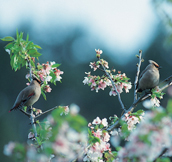
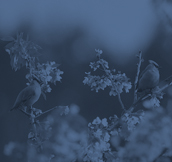 Bombycilla japonica (Japanese Waxwing) Bombycillidae
Bombycilla japonica (Japanese Waxwing) Bombycillidae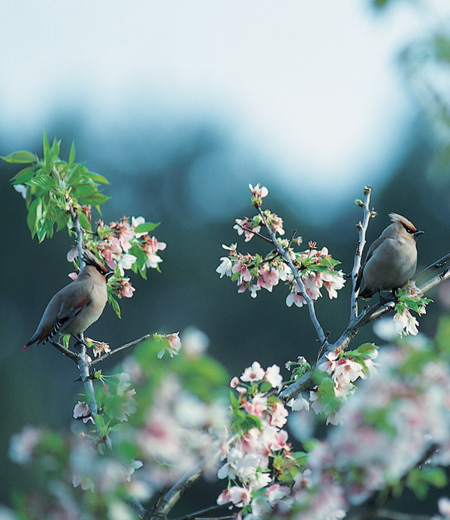 Come back to Japan around October from breeding ground in Siberia to spent winter. Found in forests in low elevations and at parks in cities. Is very similar to waxwing with reddish brown body with crown-like feathers on the head. Chirp sounding like a bell “tinkle tinkle tinkle”. The point to identify this species from waxwing is the body size. This species is slightly smaller and have red belt-like pattern on tail. Are always in a group and rest in one tree or lining up on electric wires and fly altogether. Feed on nuts of trees but some catches insects during flight. Fly back to the north before summer.
Come back to Japan around October from breeding ground in Siberia to spent winter. Found in forests in low elevations and at parks in cities. Is very similar to waxwing with reddish brown body with crown-like feathers on the head. Chirp sounding like a bell “tinkle tinkle tinkle”. The point to identify this species from waxwing is the body size. This species is slightly smaller and have red belt-like pattern on tail. Are always in a group and rest in one tree or lining up on electric wires and fly altogether. Feed on nuts of trees but some catches insects during flight. Fly back to the north before summer.
●Body Length about 18 cm
●Season October to about May (winter bird) -
Sitta europaea (Wood Nuthatch) Sittidae
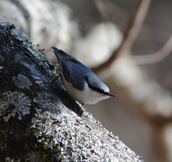
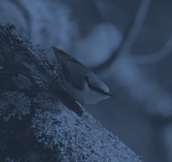 Sitta europaea (Wood Nuthatch) Sittidae
Sitta europaea (Wood Nuthatch) Sittidae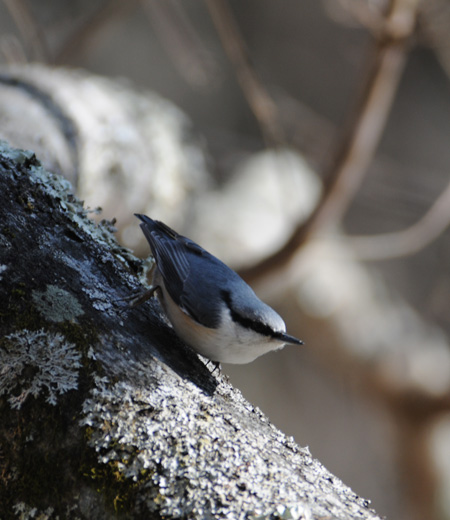 Live in broad-leaved forests with maple trees. Live alone or in pairs but some do live with other birds in a paridae family. Have strong legs and toes and distinct sharp bills. Able to hang itself upside-down from branches and hunt for insects and spiders. Place hard nuts in splits of trees and peck to crack to eat. The body color of male and female is almost the same and grayish blue from head to the back and black eye stripe. The breeding season is from April to June and male chirp “fee fee” with high tones. Re-use a nest of woodpeckers. Narrow the entrance with muds and cover the floor with fallen leaves and barks and lay five to eight eggs in a season.
Live in broad-leaved forests with maple trees. Live alone or in pairs but some do live with other birds in a paridae family. Have strong legs and toes and distinct sharp bills. Able to hang itself upside-down from branches and hunt for insects and spiders. Place hard nuts in splits of trees and peck to crack to eat. The body color of male and female is almost the same and grayish blue from head to the back and black eye stripe. The breeding season is from April to June and male chirp “fee fee” with high tones. Re-use a nest of woodpeckers. Narrow the entrance with muds and cover the floor with fallen leaves and barks and lay five to eight eggs in a season.
●Body Length about 14 cm
●Season January to December (resident bird, bird that stay in the same area all year round.)(未翻訳)鳴き声を聞く
-
Troglodytes troglodytes (Eurasian Wren) Troglodytidae
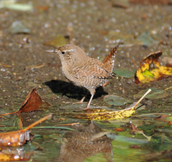
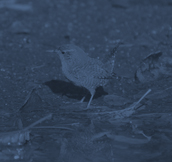 Troglodytes troglodytes (Eurasian Wren) Troglodytidae
Troglodytes troglodytes (Eurasian Wren) Troglodytidae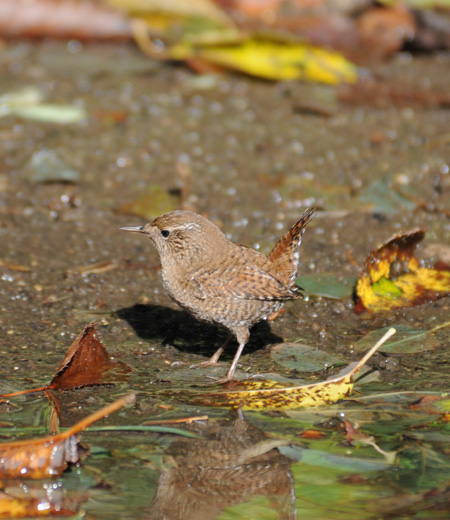 Is one of the small birds in Japan like gold crest. Live in shady forests near streams and valleys. The body color of male and female is almost the same and has irregular patterns on dark-brown body. Stay closer to the ground and jump around fallen trees and rocks with short tail upward and feed on insects and spiders. Live alone except breeding season and hardly ever come out to open bright area. The breeding season is from May to August and male rest on rocks or stubs and chirp sounding like “pi pi chui chui li li li” very loudly which is hard to believe having this loud voice from this small body. Build a ball-shaped nest under ceiling of houses in mountains, rocks and bridges and lay four to six eggs in a season. Sometimes place dead leaves covering the nest to blend them into the background.
Is one of the small birds in Japan like gold crest. Live in shady forests near streams and valleys. The body color of male and female is almost the same and has irregular patterns on dark-brown body. Stay closer to the ground and jump around fallen trees and rocks with short tail upward and feed on insects and spiders. Live alone except breeding season and hardly ever come out to open bright area. The breeding season is from May to August and male rest on rocks or stubs and chirp sounding like “pi pi chui chui li li li” very loudly which is hard to believe having this loud voice from this small body. Build a ball-shaped nest under ceiling of houses in mountains, rocks and bridges and lay four to six eggs in a season. Sometimes place dead leaves covering the nest to blend them into the background.
●Body Length about 11 cm
●Season January to December (resident bird, bird that stay in the same area all year round.)
